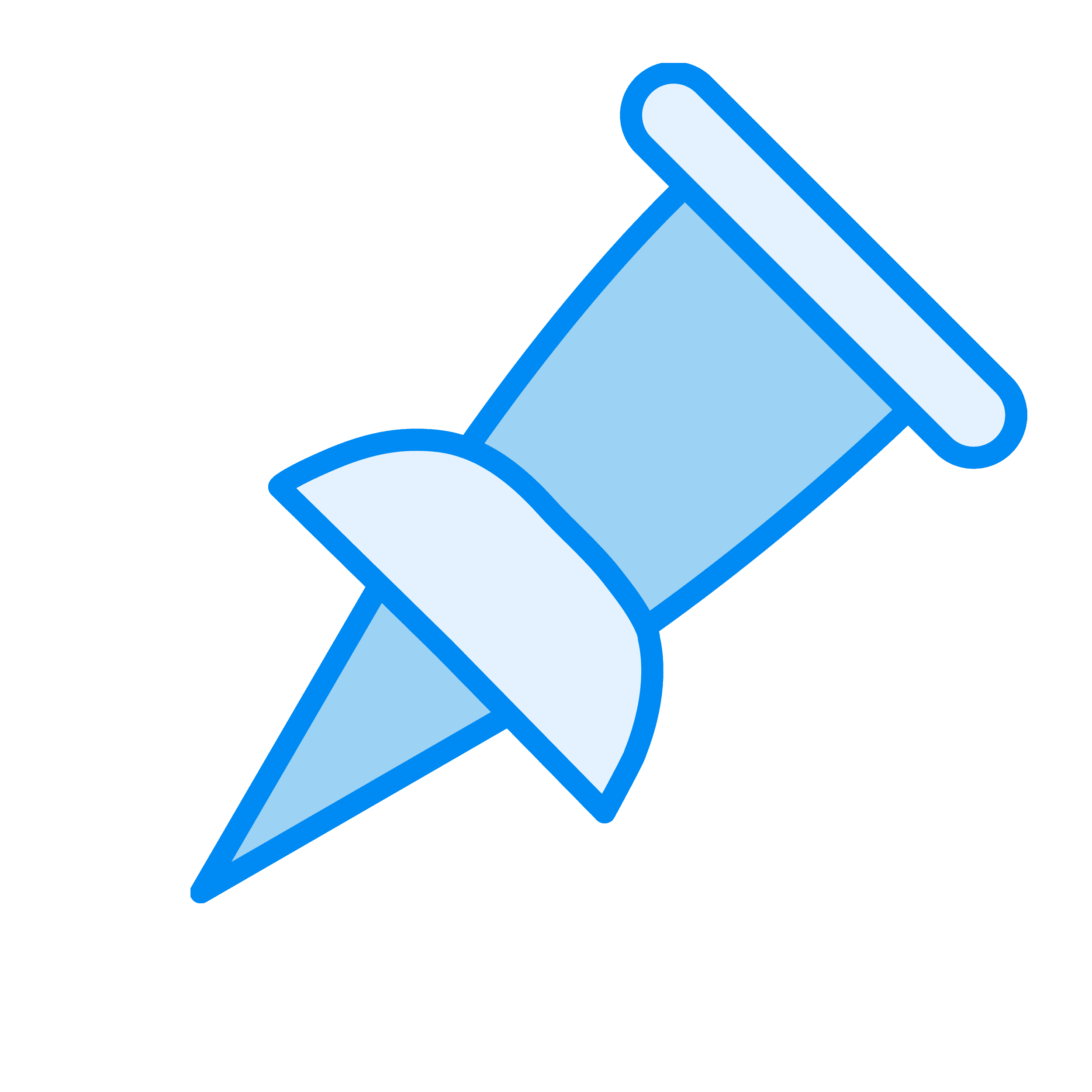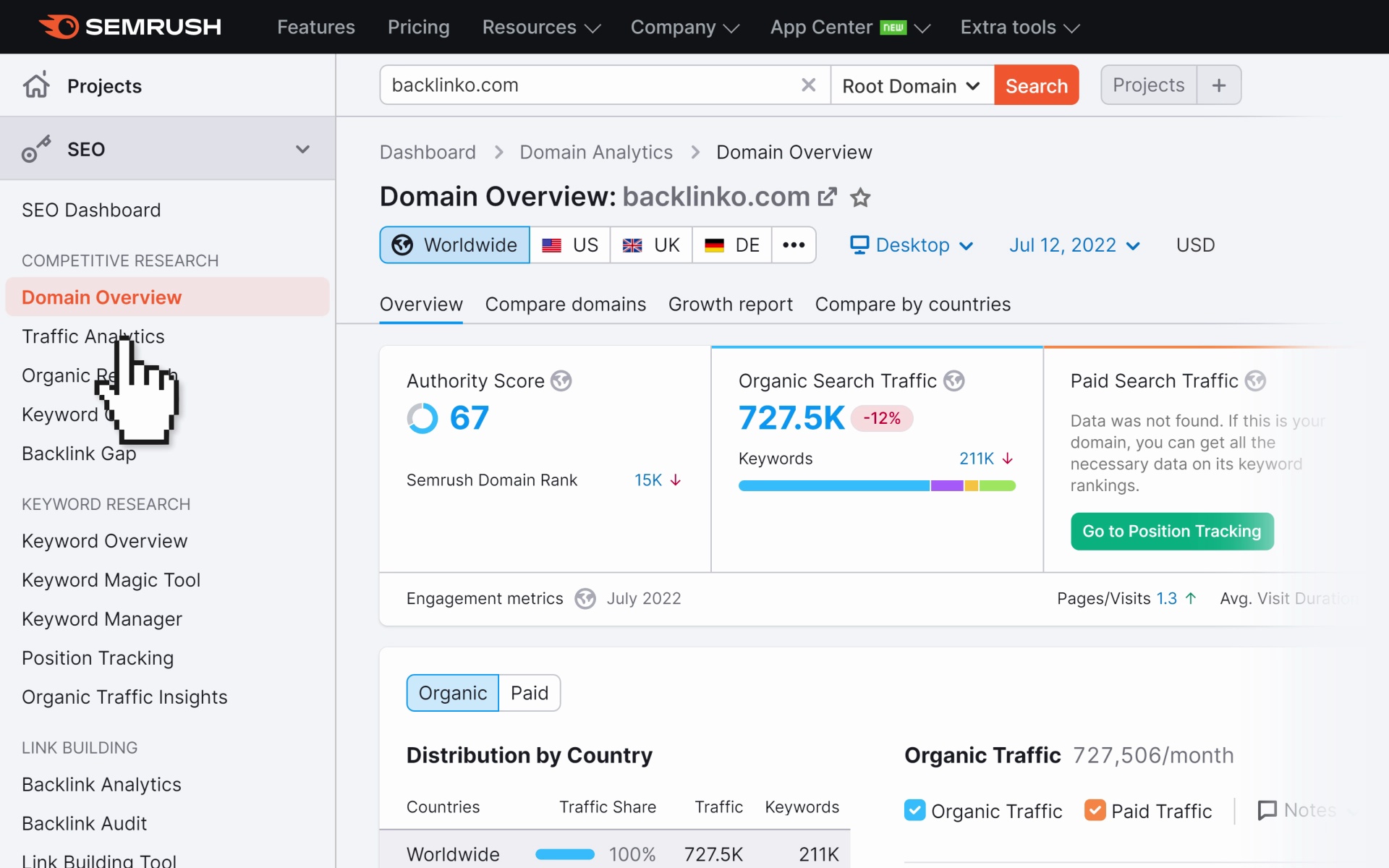When it comes to SEO tools, most promise the world but fail to deliver. After testing dozens over the years, I’ve found one that stands out: Semrush.
It’s the only tool I’ve consistently relied on to grow traffic, rank higher, and outpace the competition.
In this review, I’ll break down
- What Semrush does well
- What Semrush doesn’t do quite as well
- My opinion of Semrush’s different toolkits
- Whether Semrush is worth the monthly fee
By the end, you’ll know if Semrush is the right tool to take your SEO strategy to the next level.
Note: Semrush now offers different toolkits depending on which aspects of your digital marketing strategy you need tools for.
I won’t cover every tool Semrush offers — there are simply too many. In this review, I’ll go through each of the main toolkits and cover what I think are the most notable tools in each one.
Let’s start with the SEO Toolkit.
SEO Toolkit
The SEO Toolkit contains some of Semrush’s most powerful tools. This is probably the toolkit most people will subscribe to, since it covers some of the key tasks in any digital marketing strategy.
Let’s take a look.
Competitor Analysis
Semrush has many tools you can use to analyze your competitors’ marketing efforts. The first of these is Domain Overview.
This gives you a big picture overview of any site’s organic search, paid search, and AI visibility.
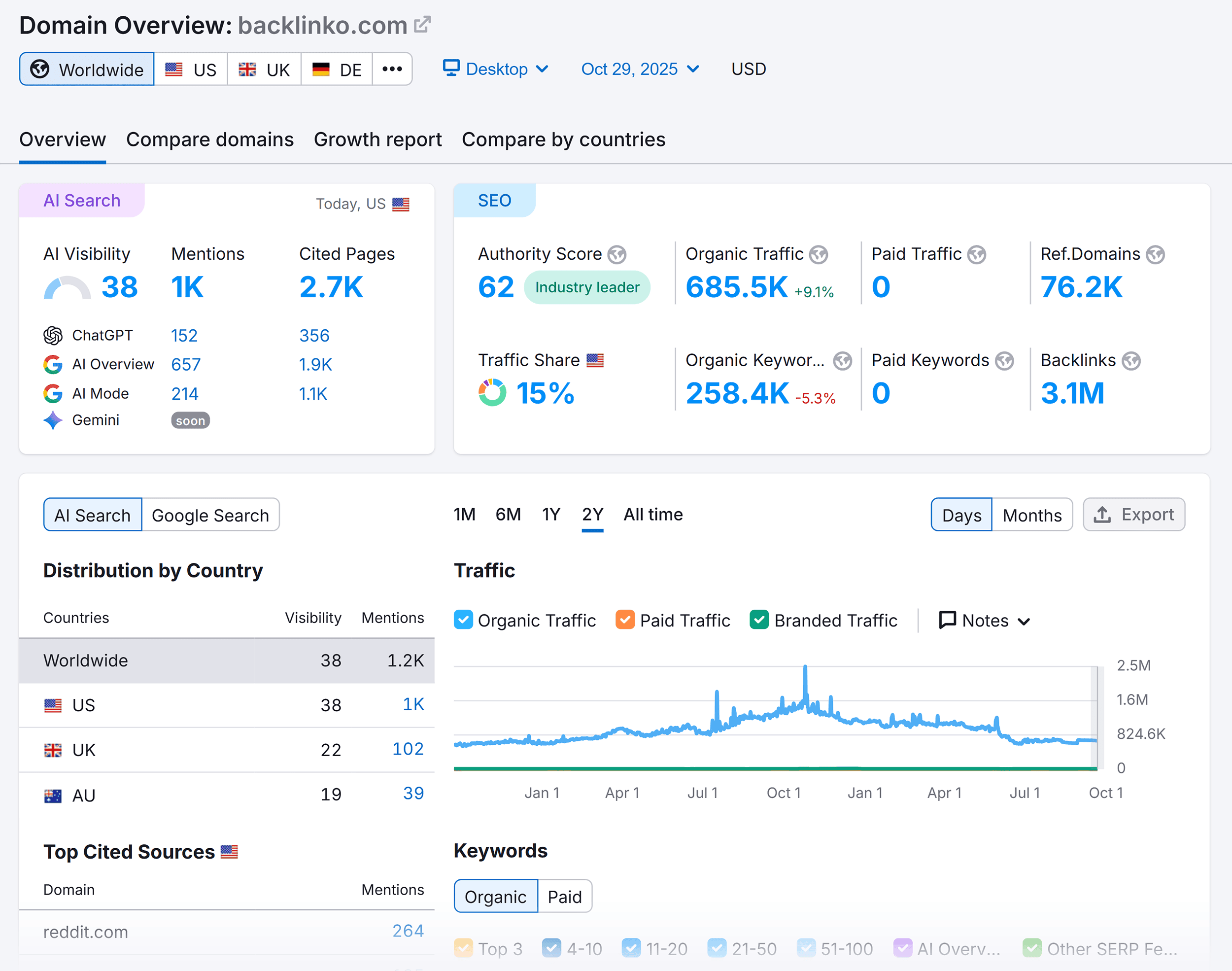
This report is helpful if you want to quickly see how much traffic a site gets from SEO or Google Ads.
You can also gain useful insights about any website’s backlink profile from this overview. You’ll see details like their top anchors and referring domains.

The Domain Overview is great for getting a high-level look at how your rivals are performing.
But Semrush’s other tools are where you can extract more specific data about a website.
For example, Organic Research tells you how much traffic a site gets from Google and how it has changed over the years.

But the report’s real value is its regularly updated list of keywords that a site ranks for in organic search. You can find it in the Positions tab.

You can see which keywords your rivals are ranking for. And you’ll see if they appear in features like featured snippets and AI Overviews.
In my experience, reverse engineering your competitor’s keywords is still one of the best keyword research strategies.
And Semrush is one of the best SEO tools on the market for this approach.
That’s because Semrush has a HUGE database of more than 25 billion keywords. And they update this list all the time.

So, Organic Research is a great place to start your analysis for finding content to create.
Speaking of keyword research…
Keyword Research
Semrush’s Keyword Magic Tool is one of the most powerful keyword research tools on the market.
Like the Organic Research tool, it’s powered by Semrush’s huge keyword database, and it lets you find thousands of relevant keyword ideas in seconds.

You just pop a seed keyword in, and the tool will provide lots of related search terms.
You can filter and sort these by metrics like:
- Search volume
- Keyword difficulty
- Search intent
This way, you’ll only see keywords related to your business that you can rank for.

Plus, if you add your domain, you’ll get AI-powered, personalized data relevant to your website. Like your own Personal Keyword Difficulty score and an estimate of the traffic you’ll get if you rank for that keyword.

This makes the Keyword Magic Tool a super useful way to find keyword ideas that can drive real results for your business.
And if you click on any of the keywords, the Keyword Overview tool lets you perform a deeper analysis on it.
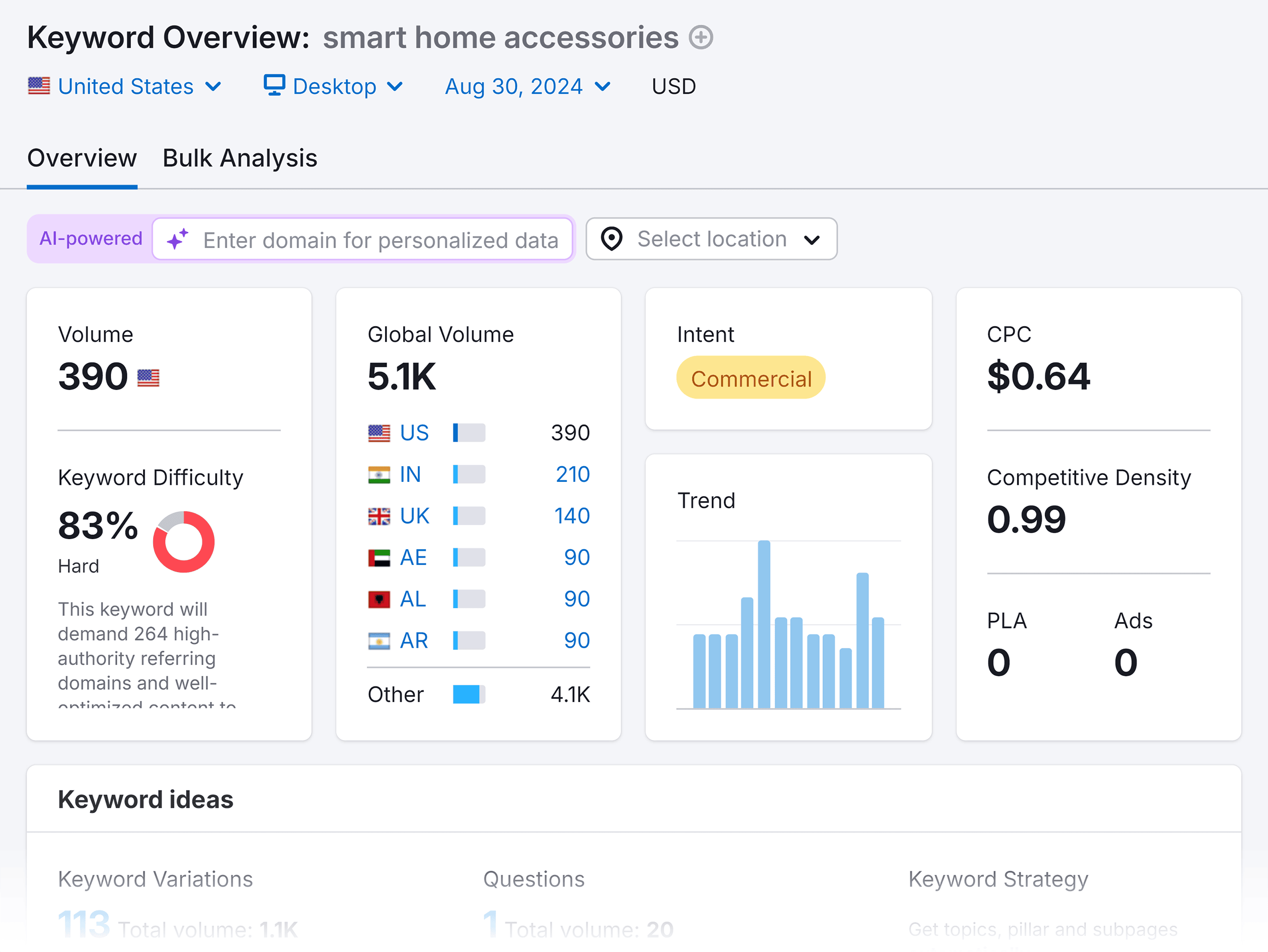
In this report, you can see a keyword’s search volume, keyword difficulty, CPC estimates, and more.
And you can see the first page competition for that keyword in the search engine results pages (SERPs).

What I like about this feature is the massive set of keyword ideas that you get.
Specifically, Semrush generates keyword ideas through variations, questions, and “keyword strategy” (which provides an example pillar page and topic clusters).

For example, here are variations that Semrush has for the keyword “social media marketing.”

Yeah, there may be some long tail keywords that you hadn’t thought of here.
But for the most part, you’ll want to use the Keyword Magic Tool for keyword discovery. And then use the Keyword Overview tool for getting more insights on specific keywords.
The final keyword research tool I want to mention is Keyword Gap. It compares your keyword ranking with a handful of competitors.
This makes it great not just for keyword research but also competitor analysis.

The idea here is that you can find keywords that many of your competitors rank for in Google, but you don’t.
And overall, it works super well.
Note: this assumes that you put in competing sites that are on or close to the same level as you are in terms of authority and overall SEO. And that are actually related to your business.
For example, when I analyzed a handful of competitors, Semrush found a list of keywords that I should optimize around.

You even get a list of terms that you and your competitors all rank for.

That way, you can find keywords you are already ranking for, but have the potential to rank higher with some on-page optimization or link building.
For example, our SEO audit checklist is ranking around fifth place in Google.
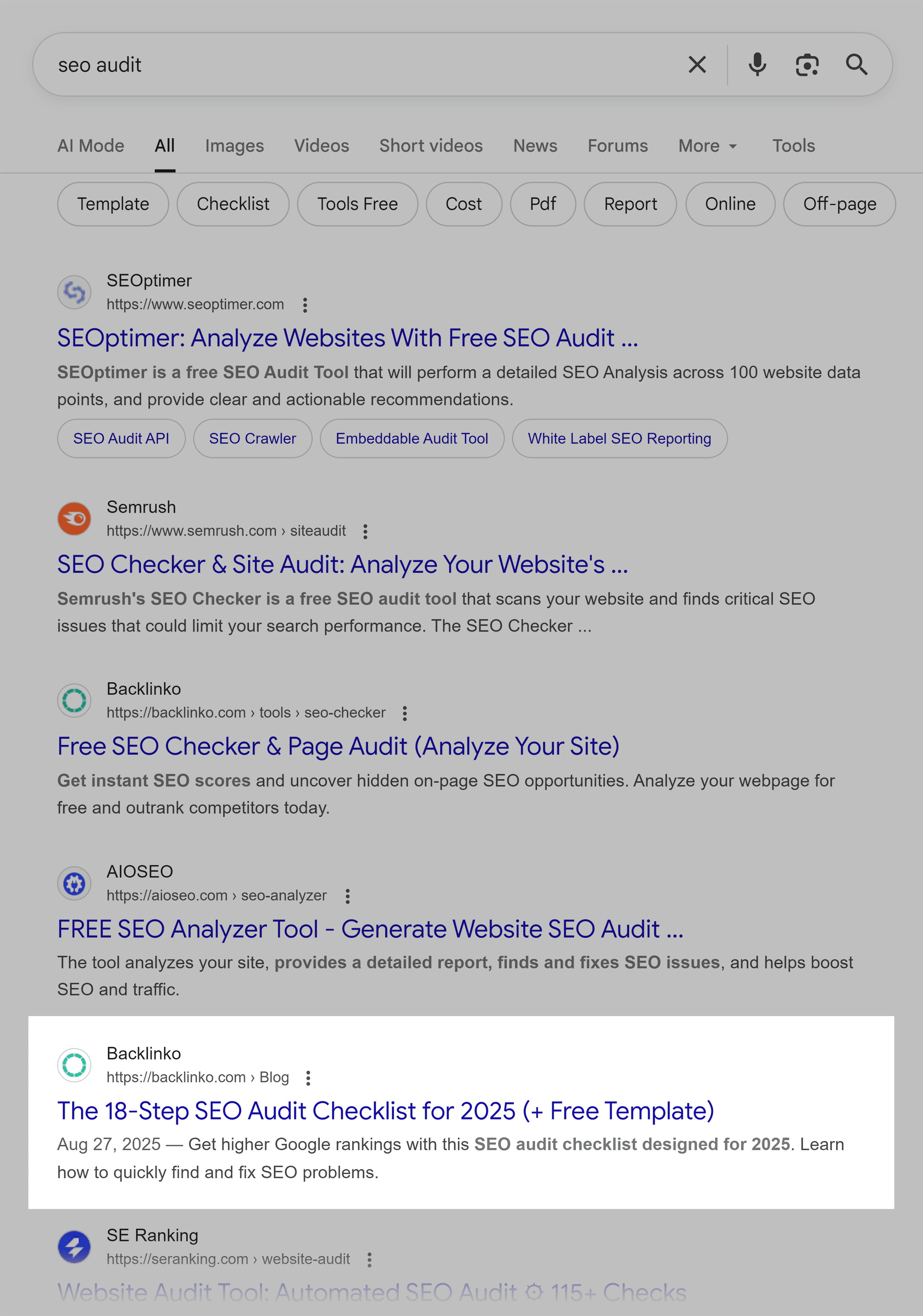
So instead of spending time on a completely new piece of content, I might be better off working to improve that page.
So while the Keyword Gap tool is great for finding, well, gaps in your keyword strategy, it’s also great for finding opportunities to improve rankings you currently have.
On-Site SEO & Tracking
Semrush also has a super in-depth SEO site audit tool built into it — aptly named Site Audit.

In my opinion, this is one of the better SEO audit tools on the market (right up there with Ahrefs).
That’s because their “Site Health” percentage score makes it easy to size up your site’s overall technical SEO health.

But if you want to get into the weeds, you can.
For example, if you run an ecommerce site with thousands of pages, Semrush will scan them all.
And give you plenty of things you can do to improve your site’s crawlability, indexing, internal linking and overall performance.
For example, Backlinko has a site health score of 71%.
That’s not bad. But, as you can see, there’s plenty of room for improvement.

Specifically, some of my pages have a large HTML size (which hurts page loading speed). This tool also tells me that I need to cache more of my CSS.
Some of these are definitely nitpicky things that won’t necessarily make a big difference in your rankings individually. But fixing lots of small issues across your site can lead to measurable results.
So if you want to make sure that your site’s technical SEO is 100% on point, Semrush’s Site Audit tool is a great way to do it.
Then, as you make improvements to your site’s SEO, monitor your results with Position Tracking.
This is Semrush’s rank tracking feature. And you can use it for both organic and paid rankings.

Like any good rank tracker, this one shows you how your rankings have shifted over time, your site’s overall search engine visibility, and your rankings distribution.
You can even see a cannibalization report. This shows any instances where multiple pages are competing for the same keywords.

Being able to track your Google Ads rankings is ideal for those running paid campaigns too.
You can use this data to ensure your campaign budget is being spent effectively and to identify ads that are not performing well.

So, the Position Tracking tool from Semrush is an essential tool for monitoring your SEO and PPC campaigns.
(I’ll talk more about PPC in the Advertising Toolkit section.)
Link Building
Semrush offers several useful tools that’ll help you with your link building efforts. First, the Backlink Analytics tool gives you access to useful data about your backlink profile and those of your competitors.

Overall, I think Semrush’s backlink checker is great, mainly thanks to its massive link index (with 43 trillion links). And it finds new pages and backlinks FAST.
While I do prefer the Ahrefs link analysis UI, Semrush’s is still really good.
Specifically, they have dozens of filters that you can use to find the backlinks that actually matter to you, whether on your own site or when you’re looking at a rival’s link profile. Like links that are active and not marked with “nofollow.”
Overall, Semrush’s backlink checker is comparable to Ahrefs in many ways.
It has a solid index. And a ton of features, like domain authority metrics (called “Authority Score” in Semrush), anchor text breakdown, number of links a site has received over time, and more.
Semrush’s backlink tool even has a few cool features that Ahrefs doesn’t have.
For example, Semrush actually breaks a site’s referring domains down into different categories.
For example, 25% of our backlinks come from sites in the “Marketing” niche. And another 25% are from websites that Semrush considers “Search Engine Optimization & Marketing.”
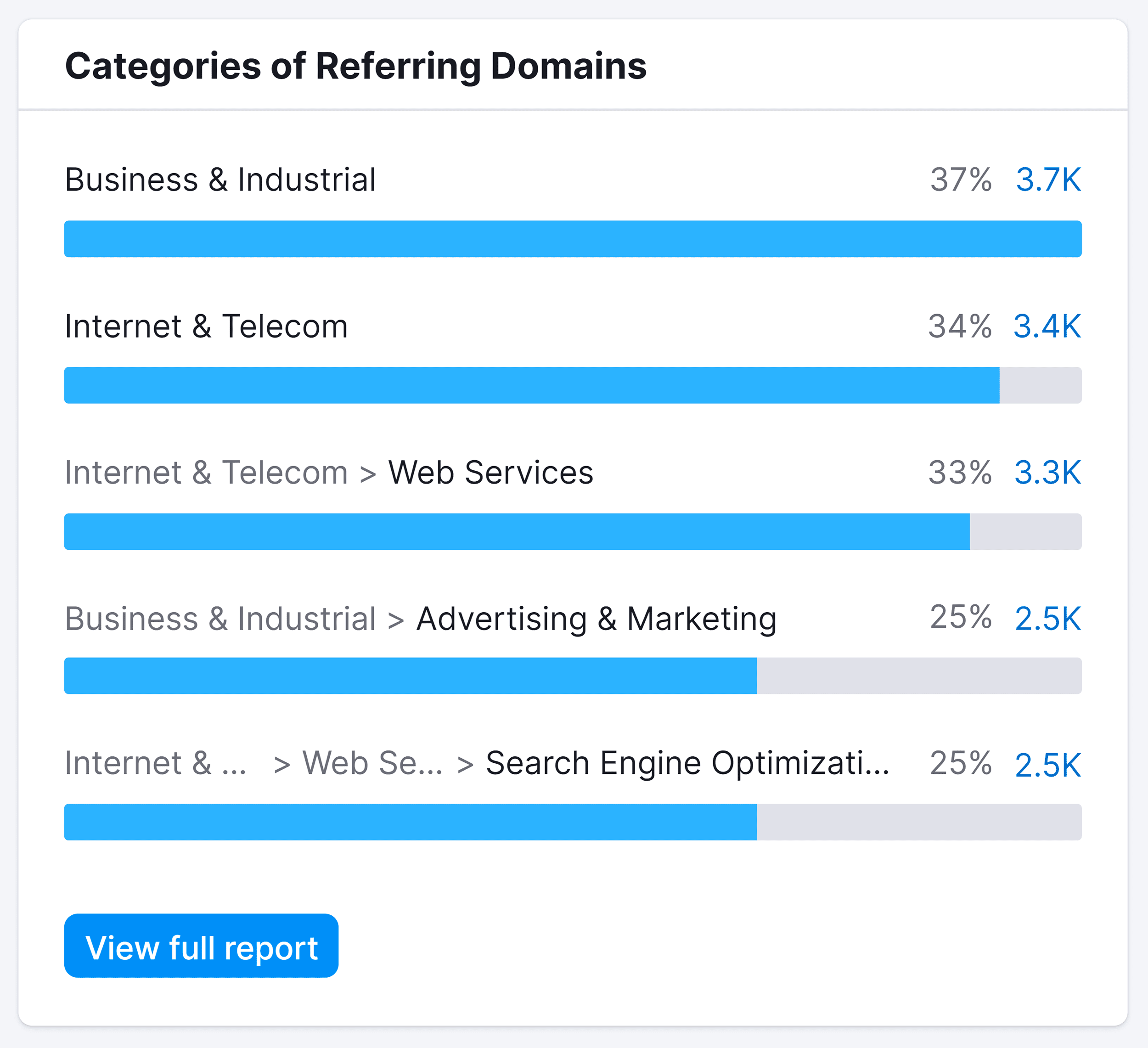
That sounds about right to me.
Backlinko is about digital marketing and SEO. So it makes sense that most of our links would come from other sites on those topics.
But if I was analyzing our competitors, this kind of data would help me understand if there are markets our competitors are getting links from that we’re not. And I could adjust our link building efforts accordingly.
Semrush also shows you a list of websites that have similar link profiles.
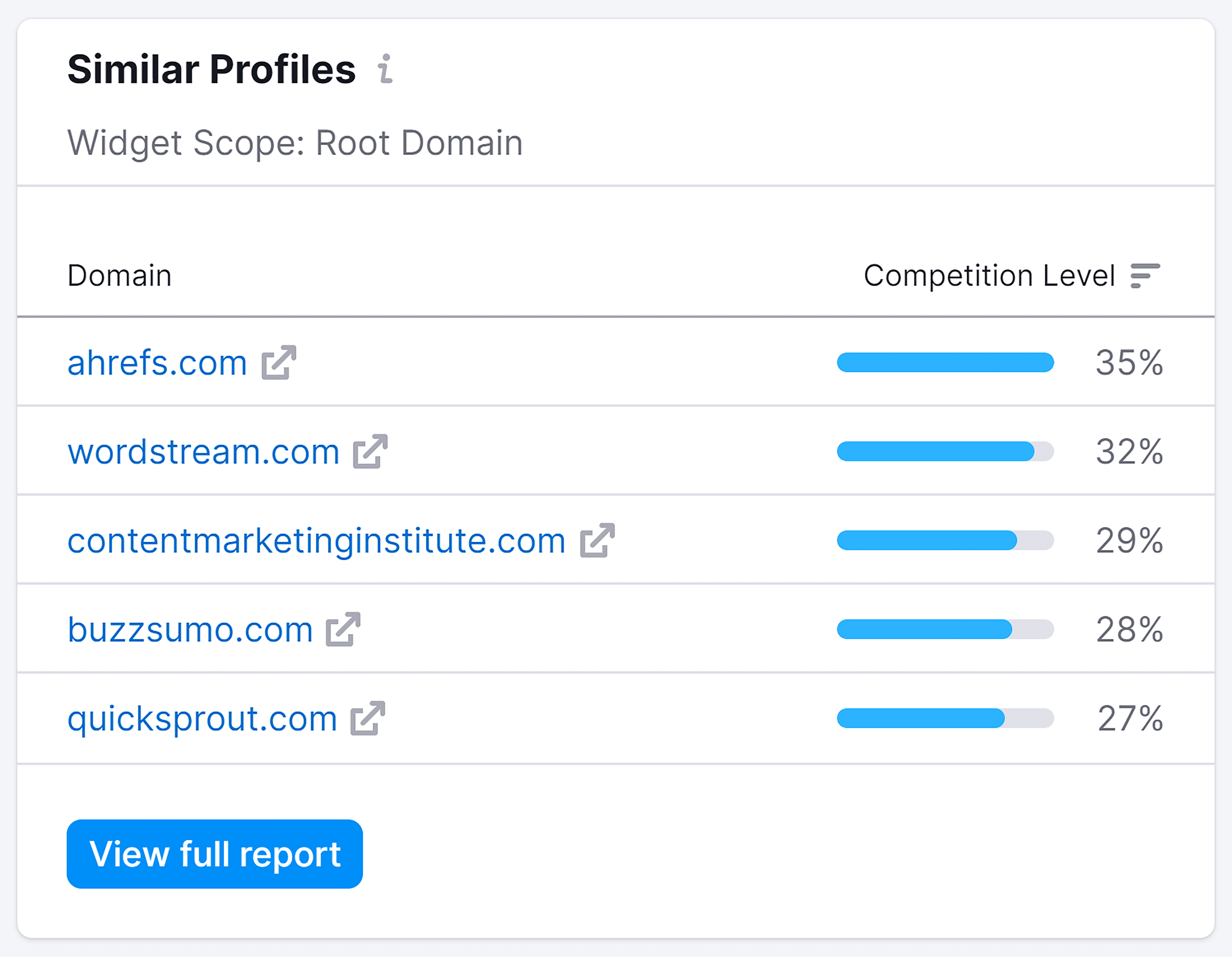
This can be super helpful if you’re kicking off a link building campaign.
Why?
Because it can help you find the right sites to reverse engineer. After all, if a site has a similar link profile to you or your competitors, it probably means that they’re getting links from places that you want to get links from.
Another link building tool worth mentioning is Backlink Audit. This gives you an in-depth report on any site’s link building profile.
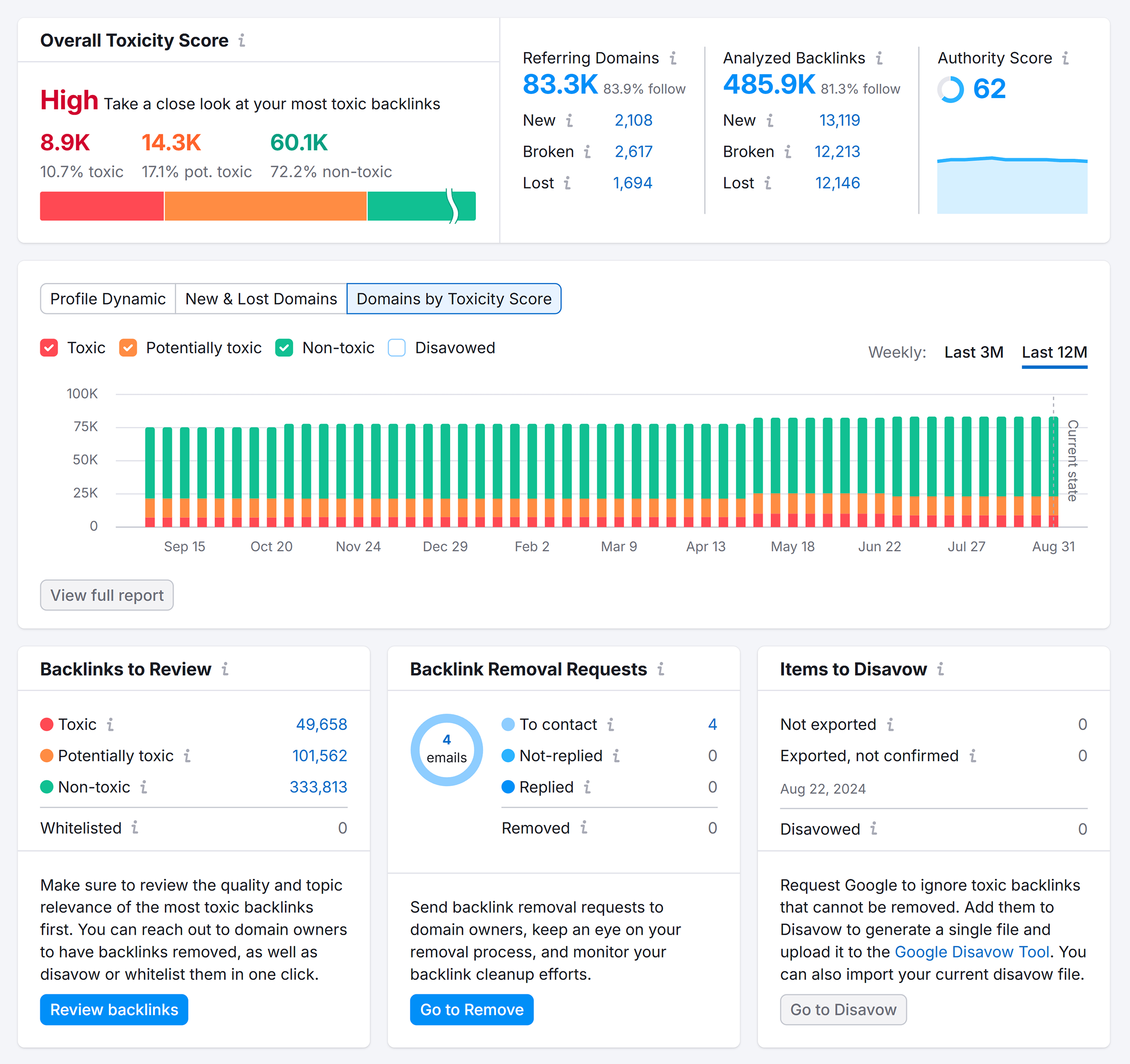
You can use it to get a deep look at the links pointing to a site. And to understand where there may be toxic links you’d rather not have pointing to your pages.
Further reading: Toxic Backlinks: How to Spot and Avoid Them
Other notable tools you get access to with the Semrush SEO Toolkit include:
- Backlink Gap to find links your rivals have that you don’t (it works similarly to Keyword Gap)
- SEO Writing Assistant for writing original, optimized content
- Topic Research to help you identify content ideas
- On Page SEO Checker to analyze and optimize your pages for SEO
- Organic Traffic Insights to combine Semrush’s powerful databases with your Google Search Console and Google Analytics data
AI Visibility Toolkit
Semrush’s newest toolkit tackles a problem every marketer has right now: how to track, compare, and improve visibility inside LLM answers.
If you care about showing up in ChatGPT, Perplexity, and Google’s AI experiences, this is where you start.
AI Analysis
This hub pulls together how often your brand appears in AI answers, which topics and prompts drive those appearances, and — crucially — what sources LLMs cite to build those answers.
You get a clear baseline, competitive context, and a short list of moves to grow share of voice.
Visibility Overview
Competing for LLM real estate is hard. Competing blind is worse.
The Visibility Overview gives you a quick read on how your brand stacks up against industry averages across major LLMs.
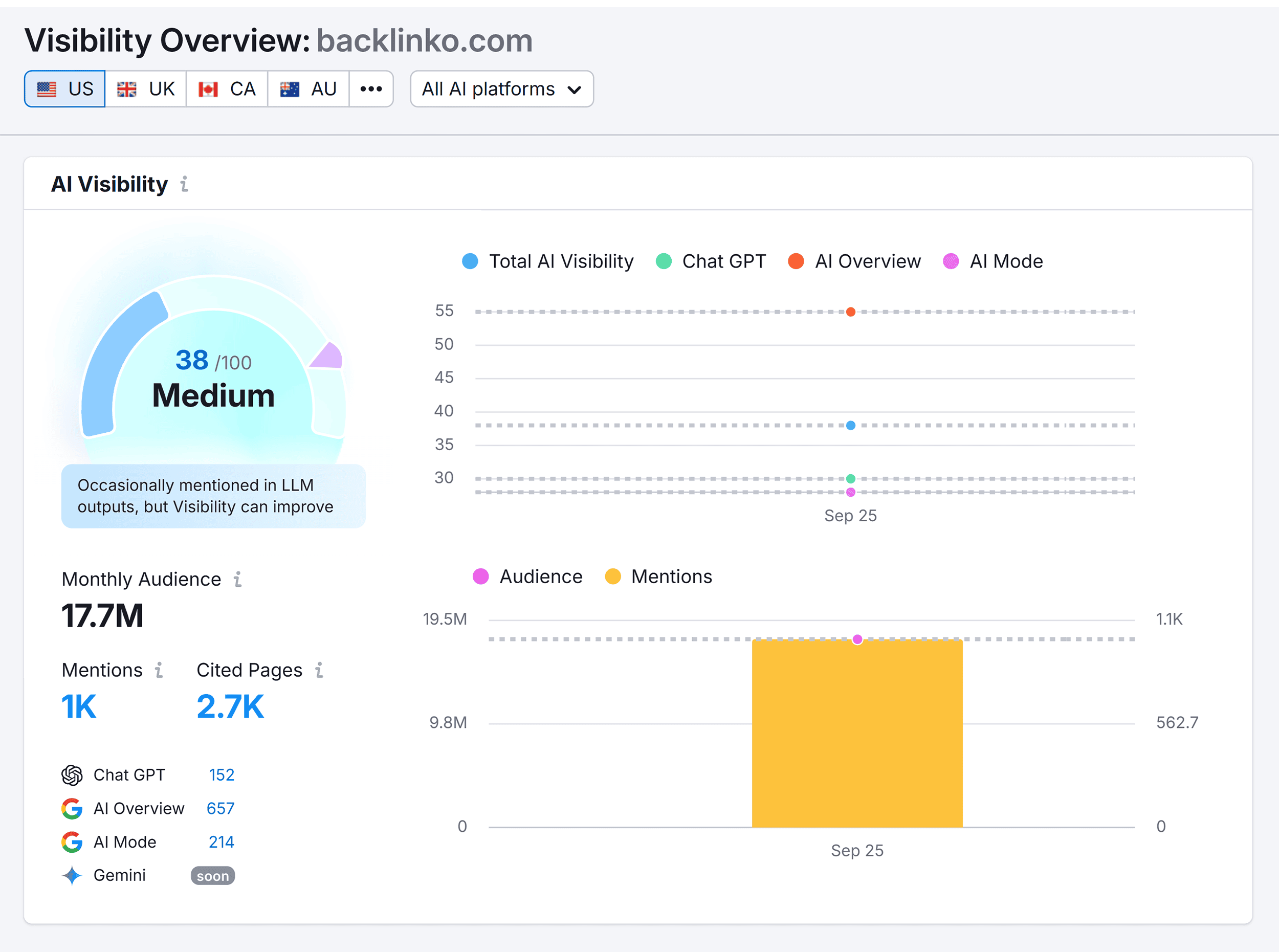
What’s powering the numbers?
Semrush blends its own prompt set with popular Google question keywords, maps prompts to your brand and category, and runs them across multiple LLMs.
The gold is lower on the page: Topics & Sources.

The Topic Opportunities tab is great for quick content ideation and understanding which topic clusters your competitors are building authority in that you’re not.
But another favorite tab of mine is Cited Sources. It reveals the sources the LLM uses for the prompt answers your brand is appearing in.
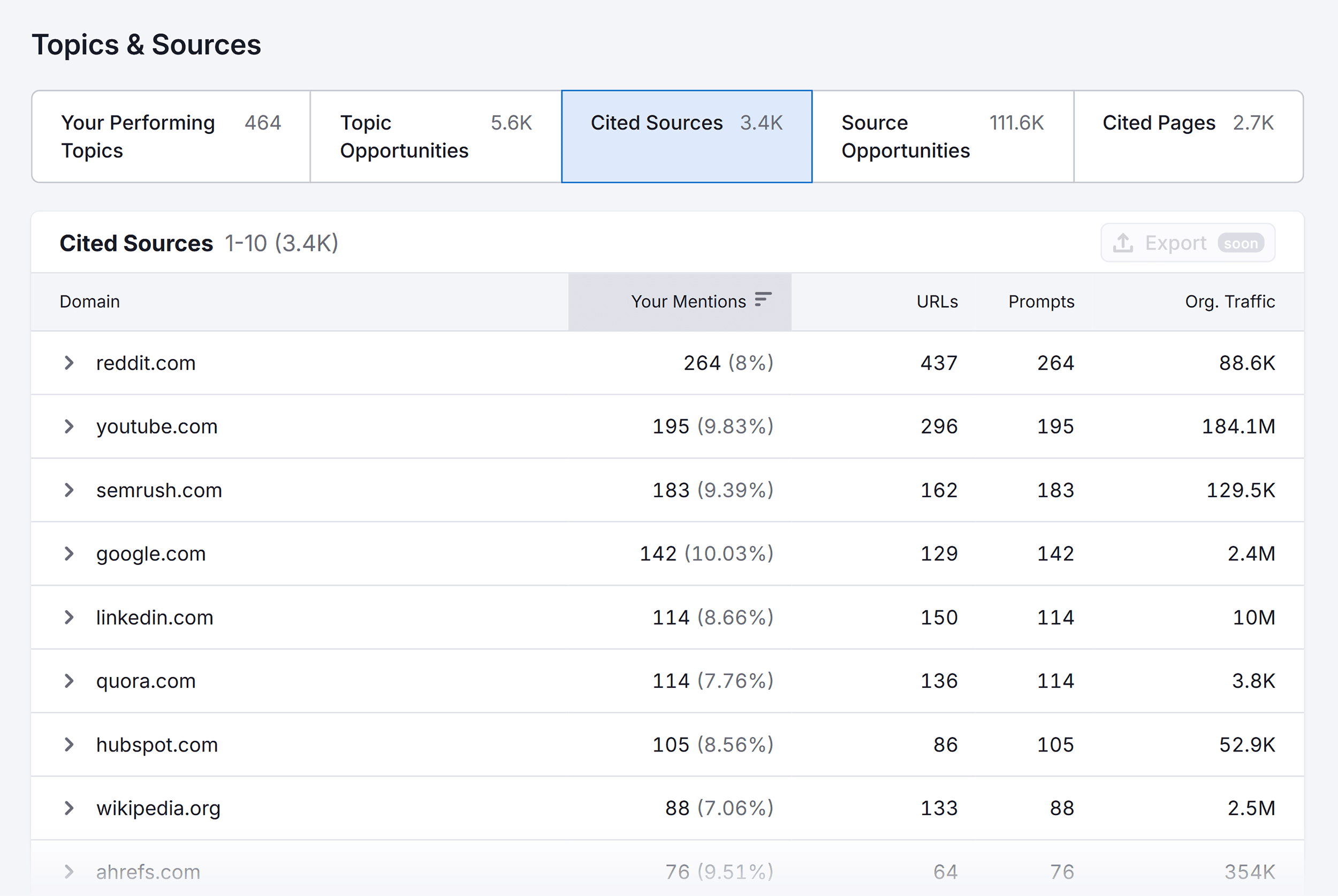
Why does this matter?
You’ll get a clear sense of what PR targets are valuable for your AI visibility, which is great for measurement and strategy validation.
Competitor Research
The Competitor Research view lets you see exactly which prompts competitors appear for that you don’t (and vice versa).
The Unique tab is sneaky-useful: it reveals topics where you’re the only one showing up.
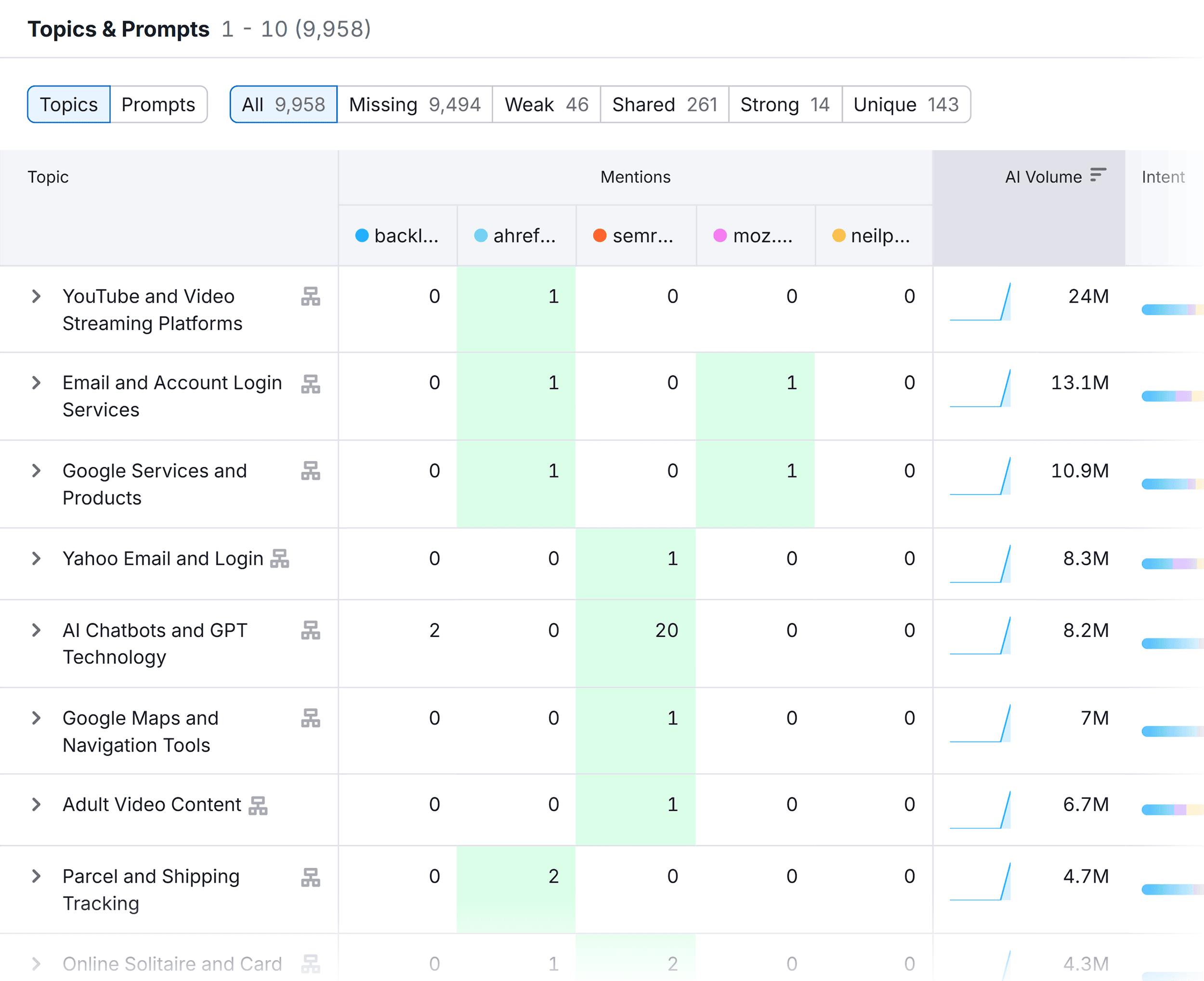
Double down on the relevant ones. Cull the out-of-left-field stuff.
Prompt Research
The Prompt Research tab lets you analyze prompts based on topics, not URLs.
For the topic you enter, you’ll see:
- Estimated AI search volume and intent mix
- Cross-LLM prompt lists
- Brands most mentioned
- Sources most cited
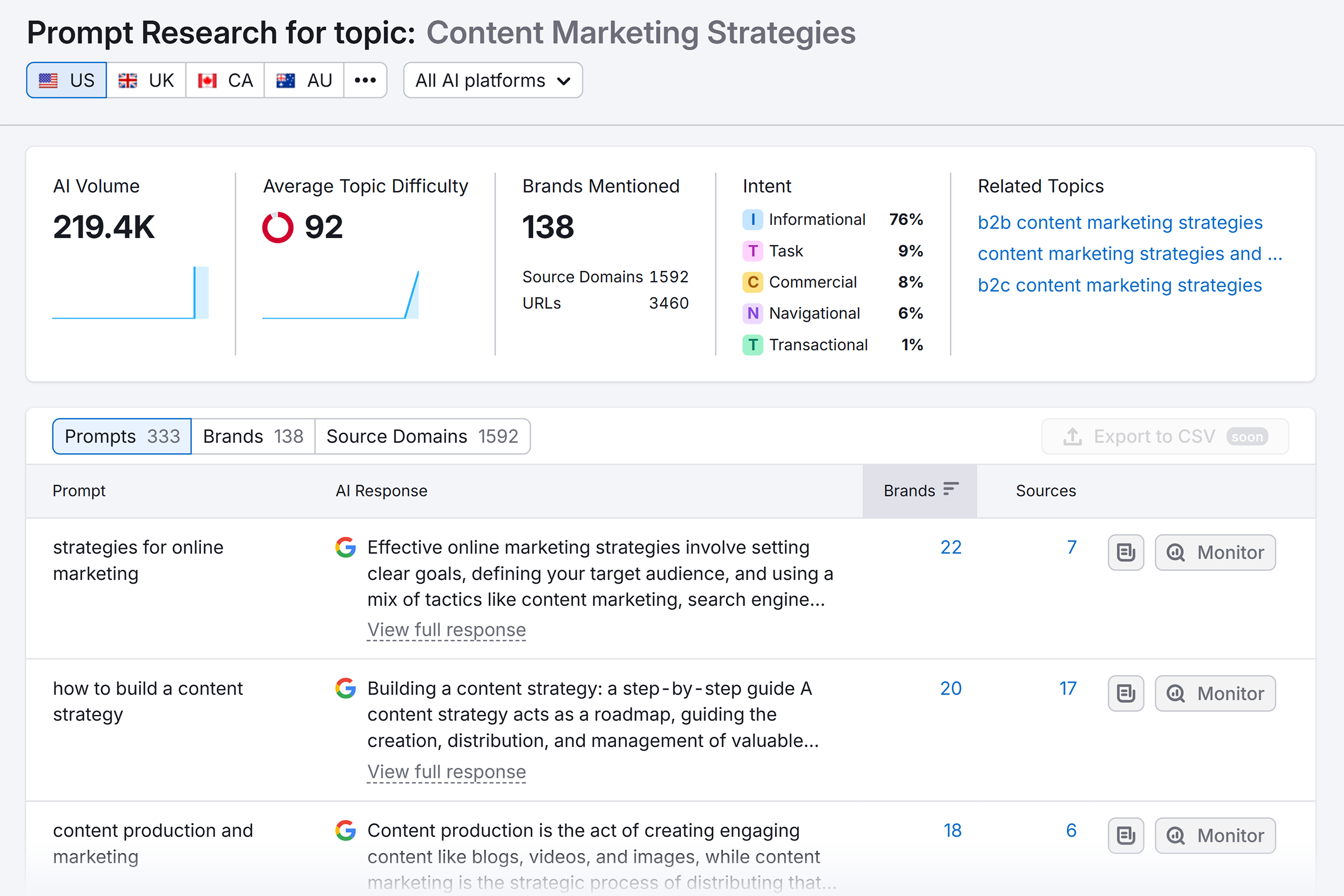
In seconds, you’ll know whether a subtopic is worth chasing, who you must beat, and which publishers you’ll need mentions from to earn citations.
Brand Performance
This section of the AI Visibility Toolkit is my favorite.
It gives you a huge amount of data you can use to understand your current AI visibility — and start improving it.
Brand Performance
The key word here is “performance.” This isn’t just about whether your brand is showing up, but how your brand is showing up.
First, you’ll see an overview of your brand’s share of voice along with some strategic insights.
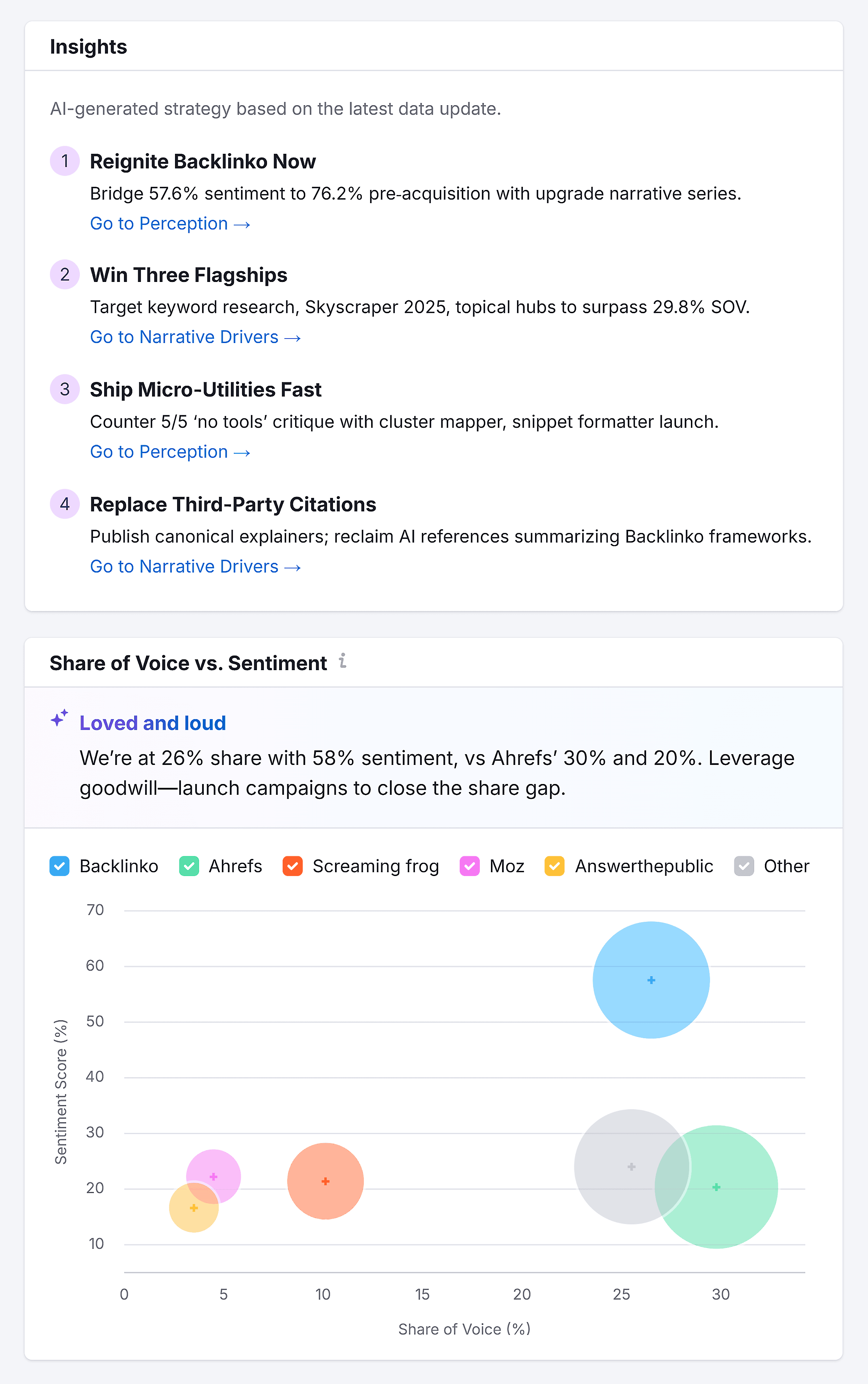
But what interests me most about this section is the introduction of sentiment.
Sure, your brand might be appearing in LLM answers, but is it in a positive way?

Unless you believe all press is good press, you’re going to care about brand perception, since that’ll have a direct impact on conversion and revenue.
Next, the Key Business Drivers section takes a minute to digest, but it’s well worth it.

This part basically shows you what story your brand is telling.
In the example above, Backlinko is winning at Performance & UX topics but needs to improve on Data-Led Content Assets (we’re a little behind Ahrefs on that front).
And remember: This isn’t just about volume. Semrush is looking at “recurring patterns in AI-generated answers about your brand and competitors.”
Perception
Perception in general is inherently hard to measure. So I’m glad to see it has its own subsection in this toolkit.

Again, you get more up-front insights as food for thought. But you also get sentiment by AI platform and sentiment changes over time.
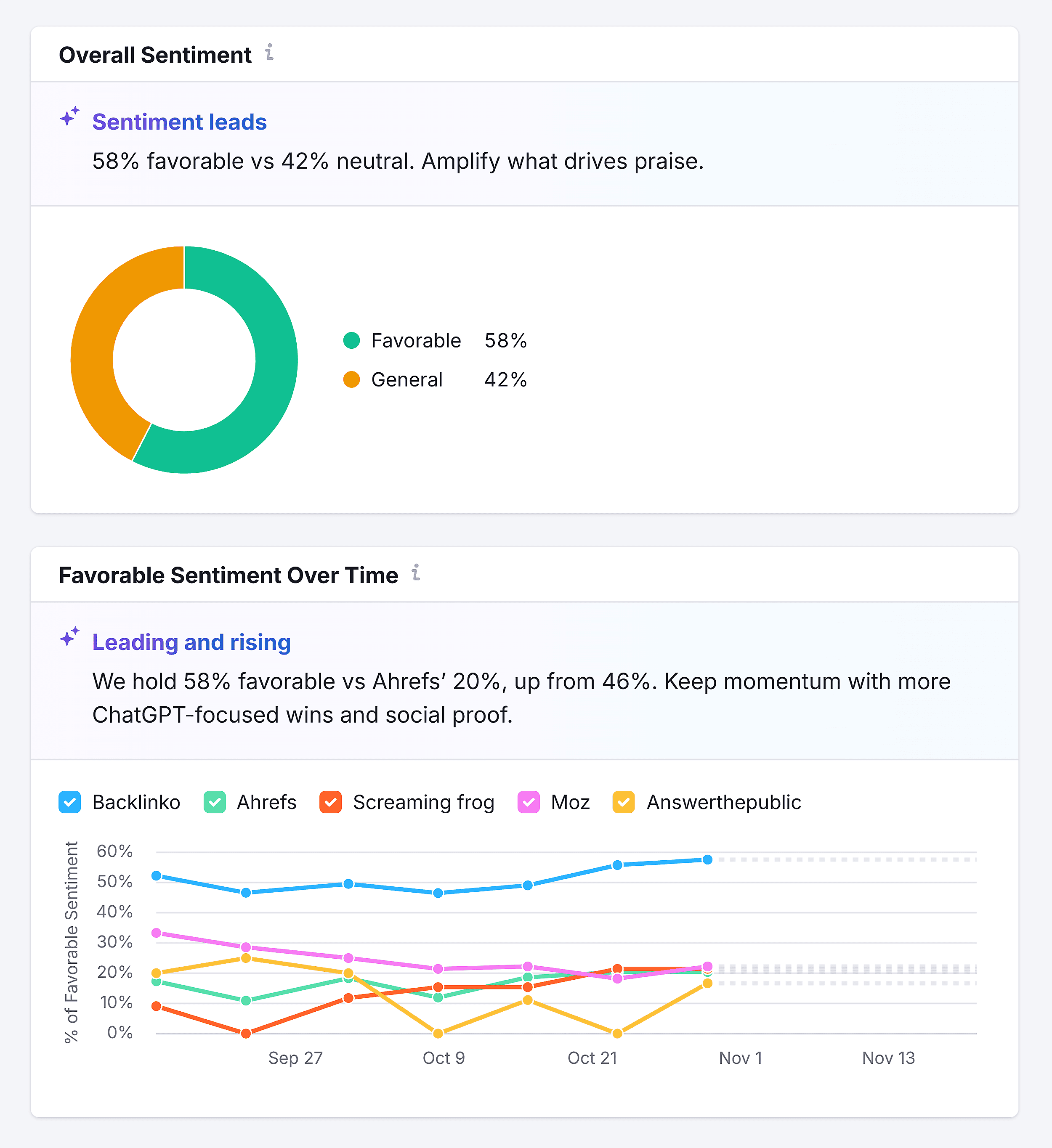
This can show you if you need to make your strategy more nuanced to improve your standing on a particular LLM. Or if a strategy is on the right track (or not, if sentiment is dropping).
At the bottom, you’ll see some of the factors that may be contributing to the sentiment in each tool.

These factors can inspire new areas of focus, identify topics you need to develop content for, or flag brand messages that have fallen flat.
Narrative Drivers
In this report, you can filter for branded vs. non-branded LLM answers and citations.
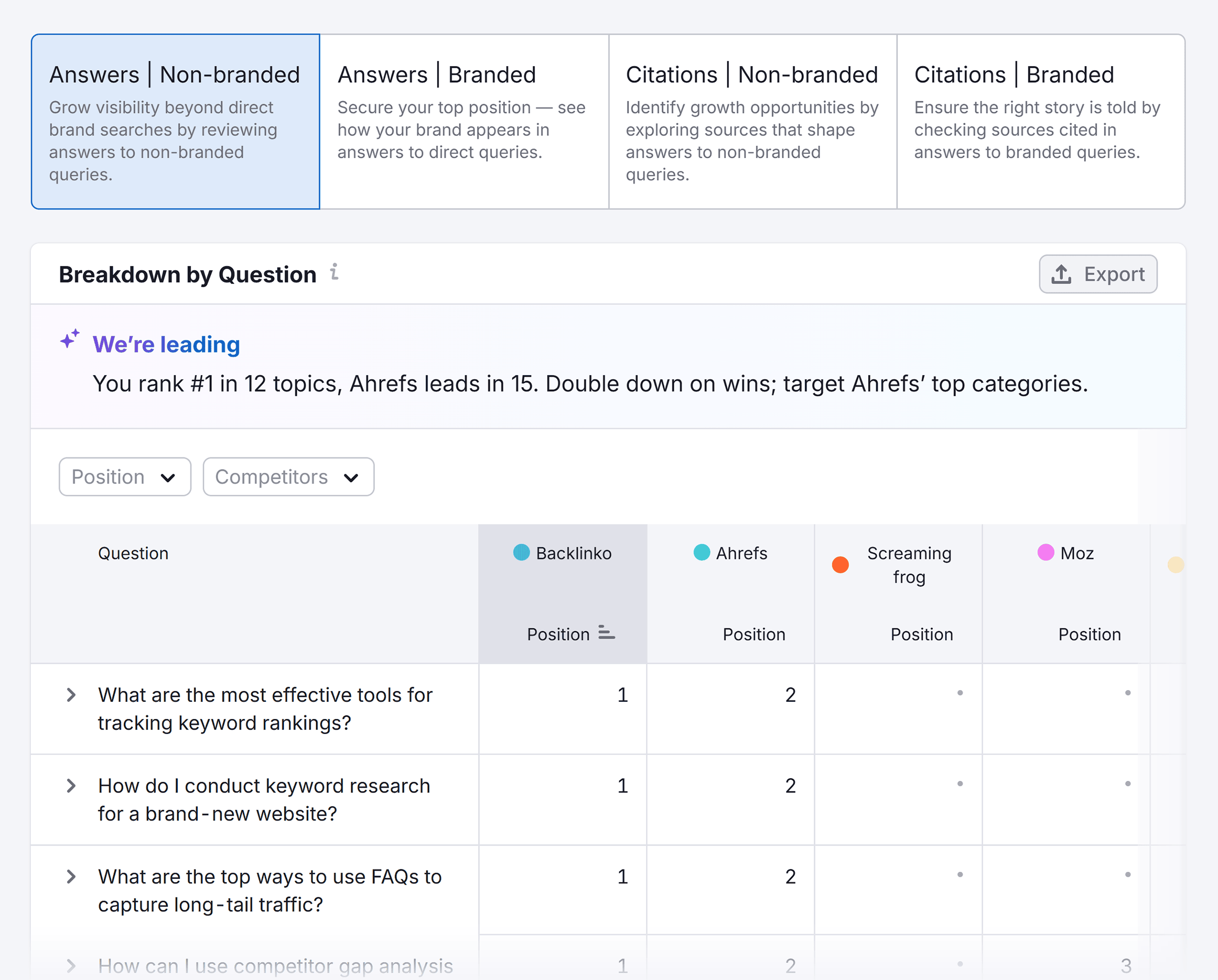
Just like with keyword analysis, it’s vital to differentiate between branded and non-branded strengths and weaknesses.
For example, let’s say you’re finding that a vast majority of your LLM mentions are non-branded, and competitors are handily beating your company in branded mentions.
That’s a strong indication that your content is great, but you need to boost your off-site brand authority.
These granular insights can therefore help guide your broader marketing strategy.
Questions
This section breaks query intent down by topic cluster, along with the questions your brand is successfully answering for each subtopic.

This level of specificity can help you round out your content strategy and understand where the gaps are. And which additional questions you can answer that meet other kinds of intent.
This section also has the added benefit of some great graphs you can use when reporting to other teams and higher-ups. Particularly the Topic Distribution and Query Intent Distribution graphs, which provide a great snapshot of how your brand is appearing in LLMs.

Boost and Monitor
This final section of the toolkit is where strategy turns into ongoing execution.
Two tools live here: an AI-aware site audit and prompt-level tracking that finally makes LLM performance feel like SEO analytics.
Site Audit
While you can access the full Site Audit tool as part of the SEO toolkit, you’ll also get access to an AI search-specific site health widget for up to 100 pages with the AI SEO Toolkit.
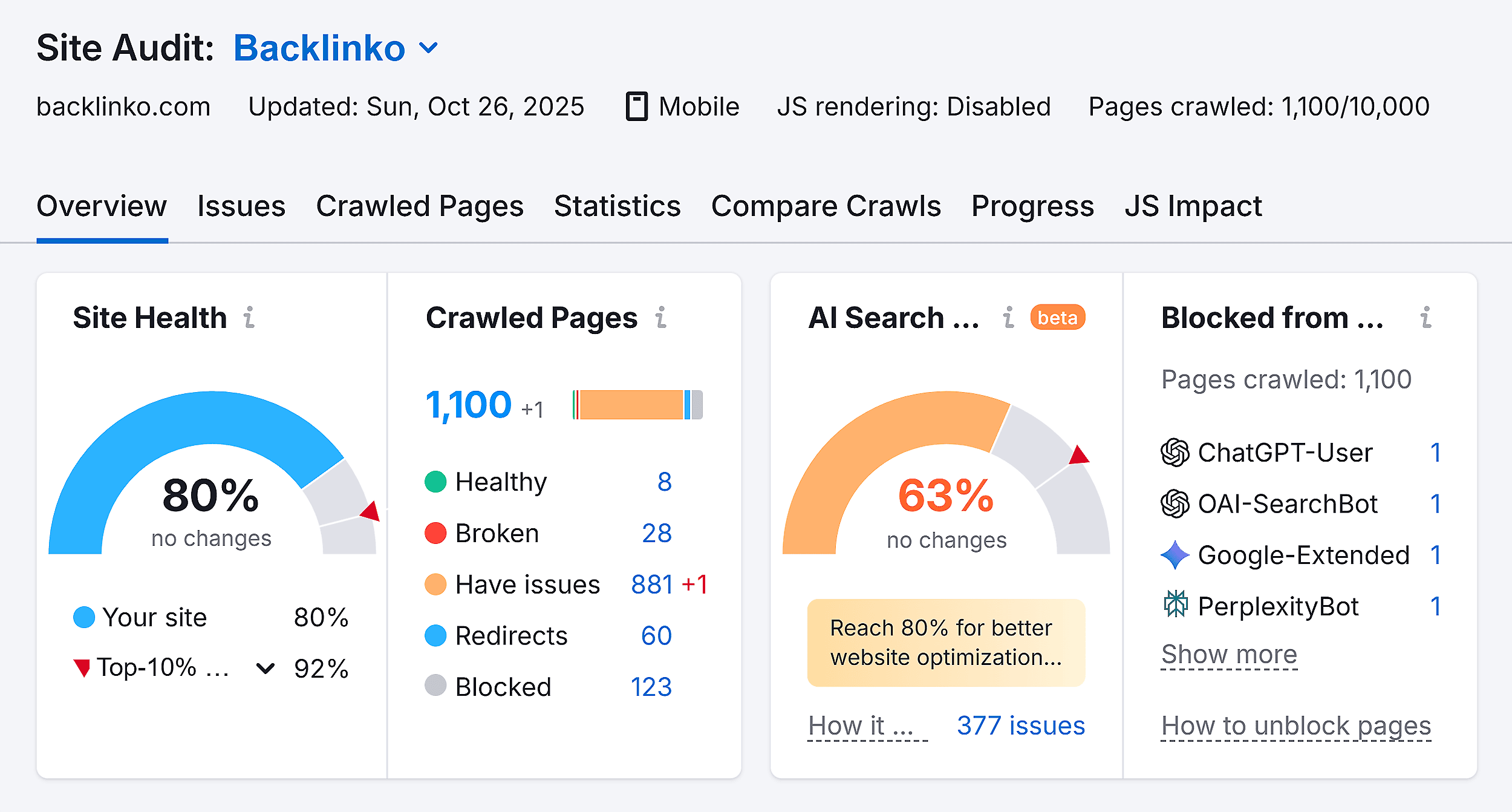
It checks for pages that are blocking LLMs. Which is key, because if the tools can’t see your pages, they can’t cite them in their responses to user prompts.
Prompt Tracking
LLM analytics are hard to come by, but now Semrush is able to provide metrics like visibility and average position over time.
These screenshots are for Backlinko’s performance on ChatGPT specifically.
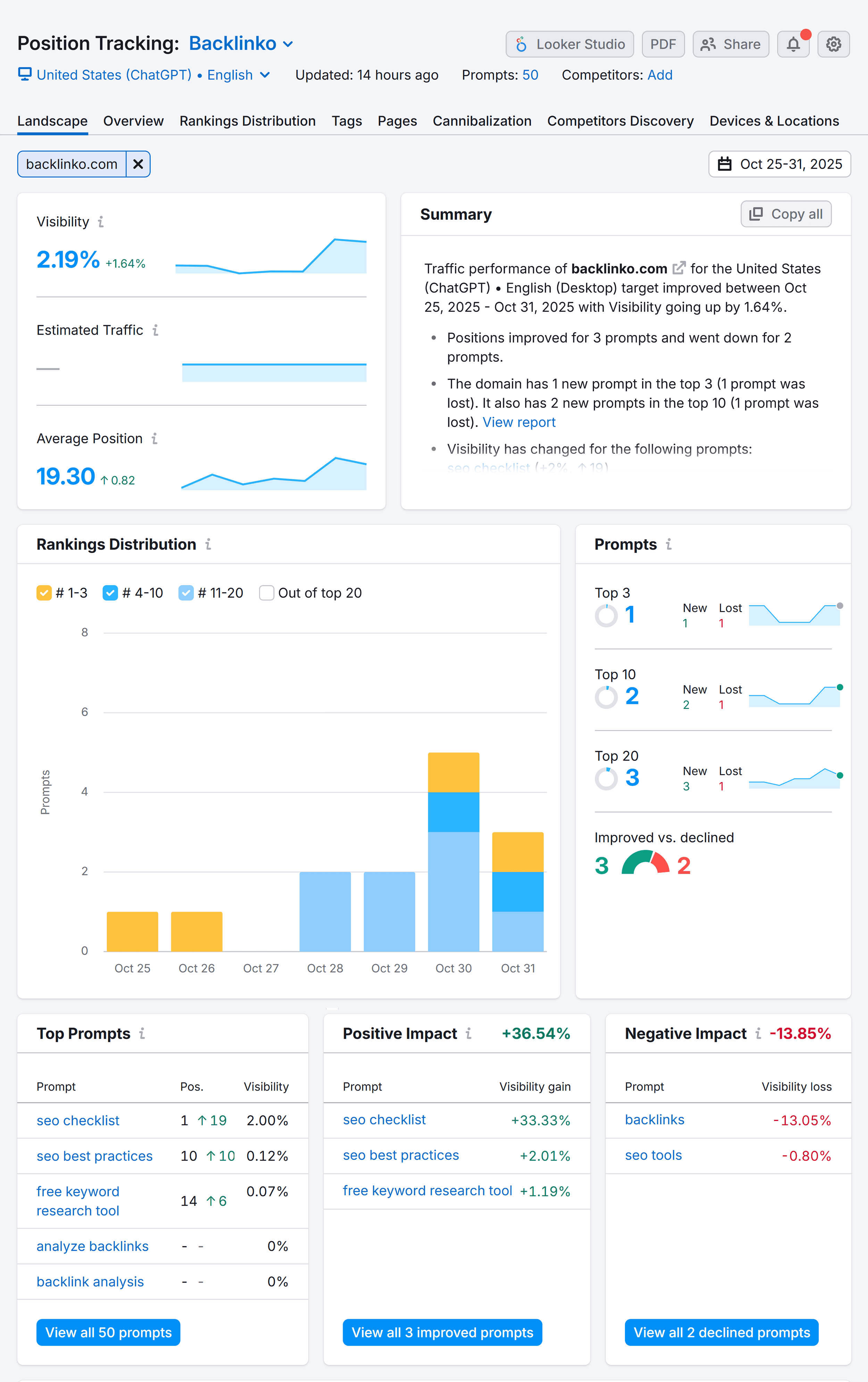
It’s really encouraging to start seeing analytics dashboards for LLM performance looking so similar to the SEO analytics we’re used to.
The amount of specificity here, especially the position and visibility data for specific prompts, will be transformational for how marketers approach AI SEO, especially those using the Seen & Trusted Framework.
Traffic & Market Toolkit
Semrush offers several great tools for understanding your target market and audience. Audience research in particular is essential if you want to create content that reaches and resonates with your target customers. And the tools below can help A LOT.
Let’s start with the traffic analysis tools.
Traffic Analysis
The Traffic Analytics tool shows you details about a website’s traffic. Including where it came from, how users interact with the website, and even what percentage of them make a purchase.

The tool also shows you the distribution of the site’s traffic across different channels like direct, referral, and organic search.
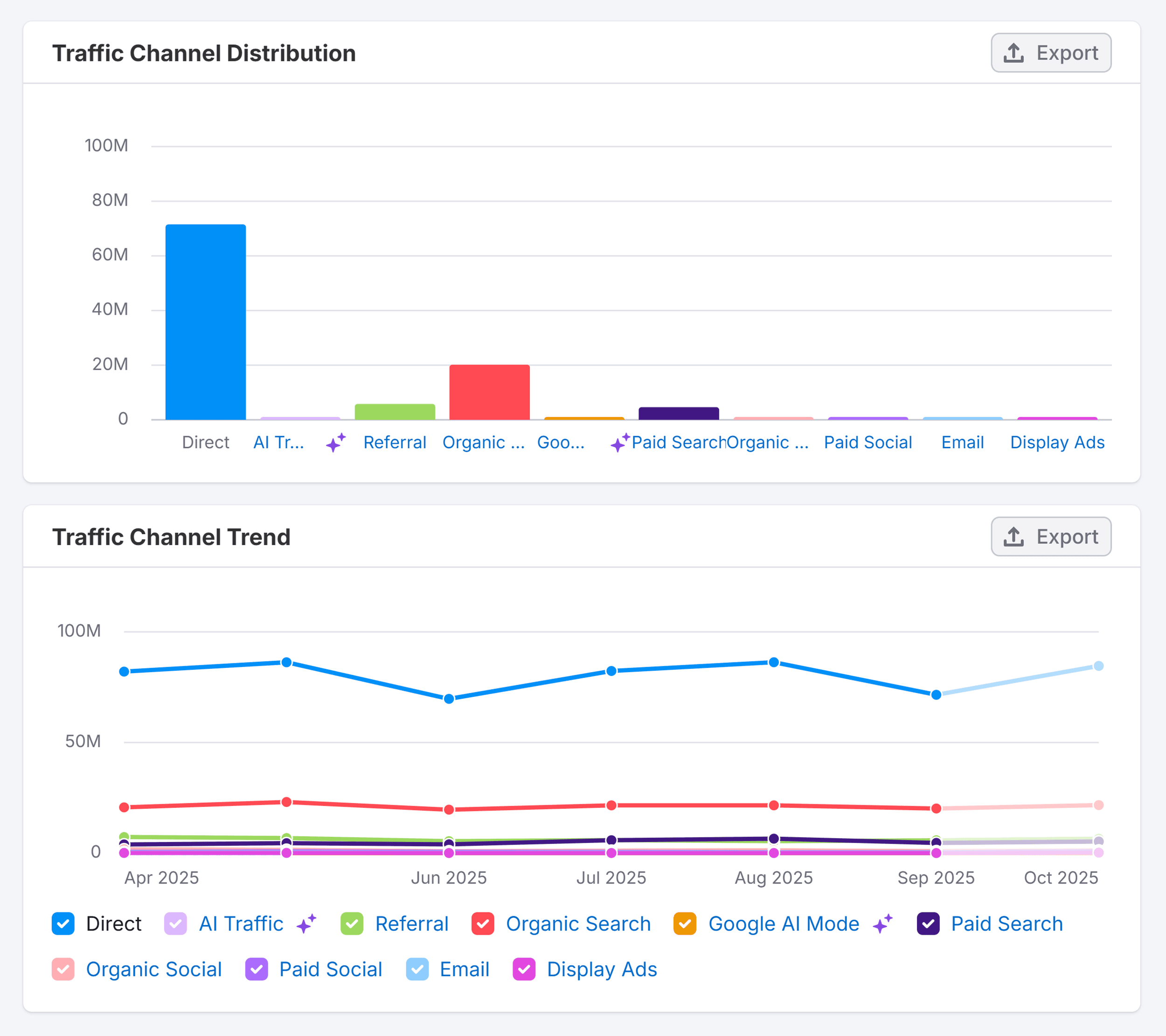
This can help you understand which marketing channels your competitors are using that you might have neglected.
The AI Traffic report shows you how much traffic a site gets from LLMs like ChatGPT, Perplexity, and Google’s AI tools.
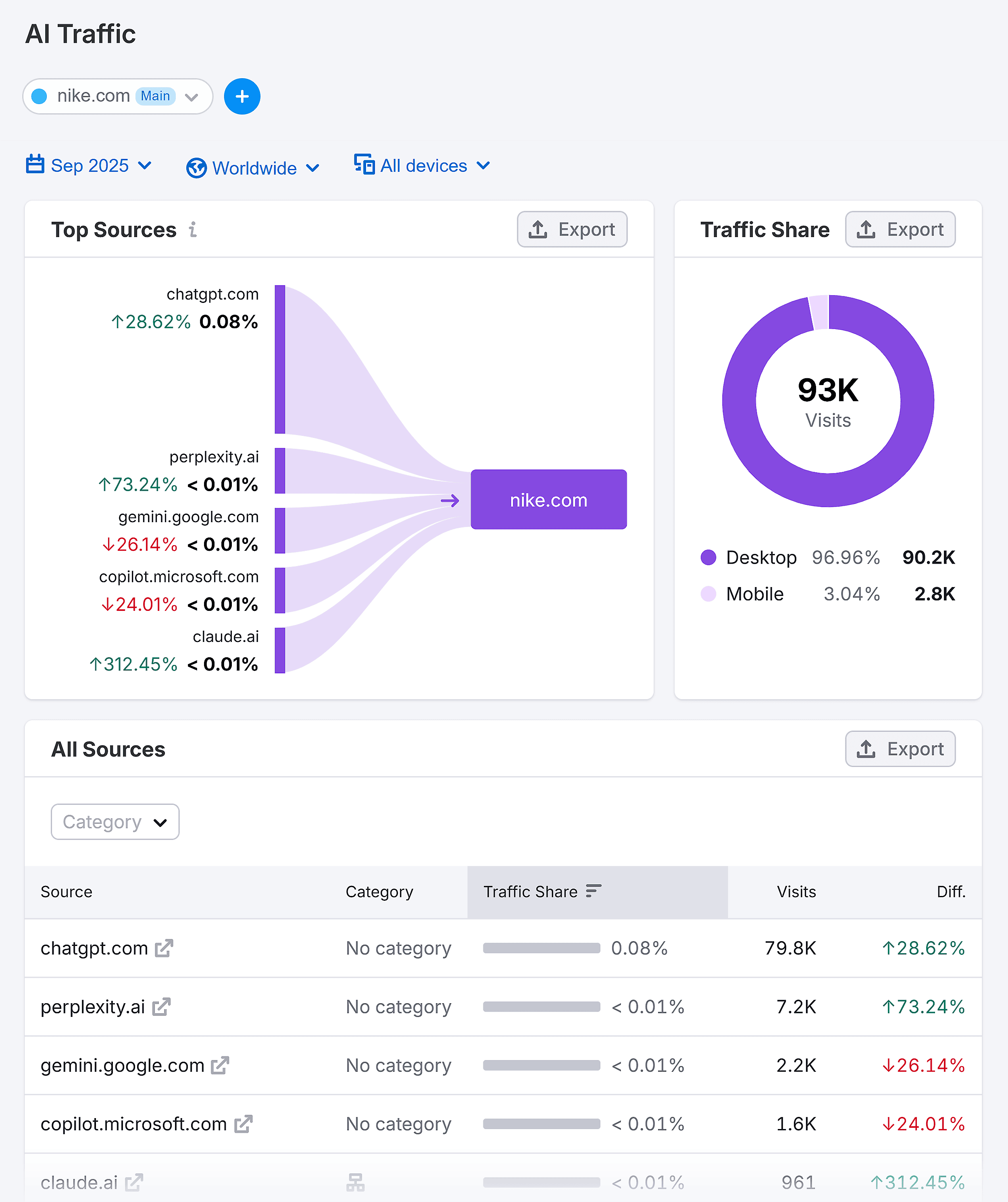
This provides a super useful overview of what are becoming vital traffic sources in the modern marketing world.
You can see similar breakdowns for:
- Referral traffic
- Organic search
- Paid search
- Organic social
- Paid social
- Email traffic
- Display ads
Audience Research
To help you understand your target audience, Semrush has four super useful tools.
The first is the Audience Overlap report. This shows you all the sites your website visitors also go to.
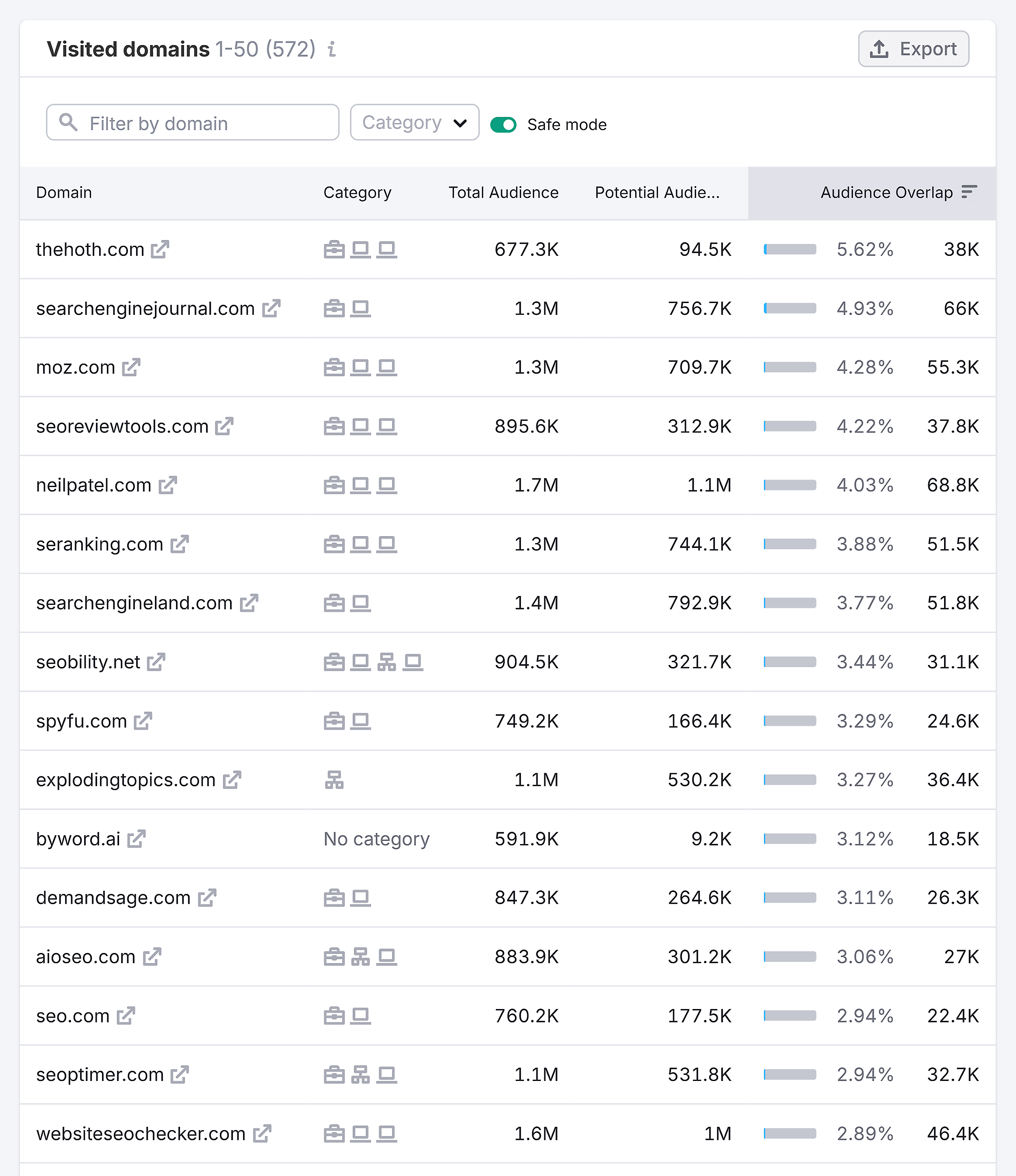
This can help you understand the other content your audience likes. But it’s also a handy insight if you’re looking to run paid ads or sponsorships on other sites too, since this data can suggest websites that might yield the best results for your campaigns.
The Demographics report gives you handy details about your audience’s age, sex, and geographical distribution.

You can use this data to better cater your content (and paid ads) to your ideal audience. You get even more useful data in the Socioeconomics tab, like household size, income level, and employment status.
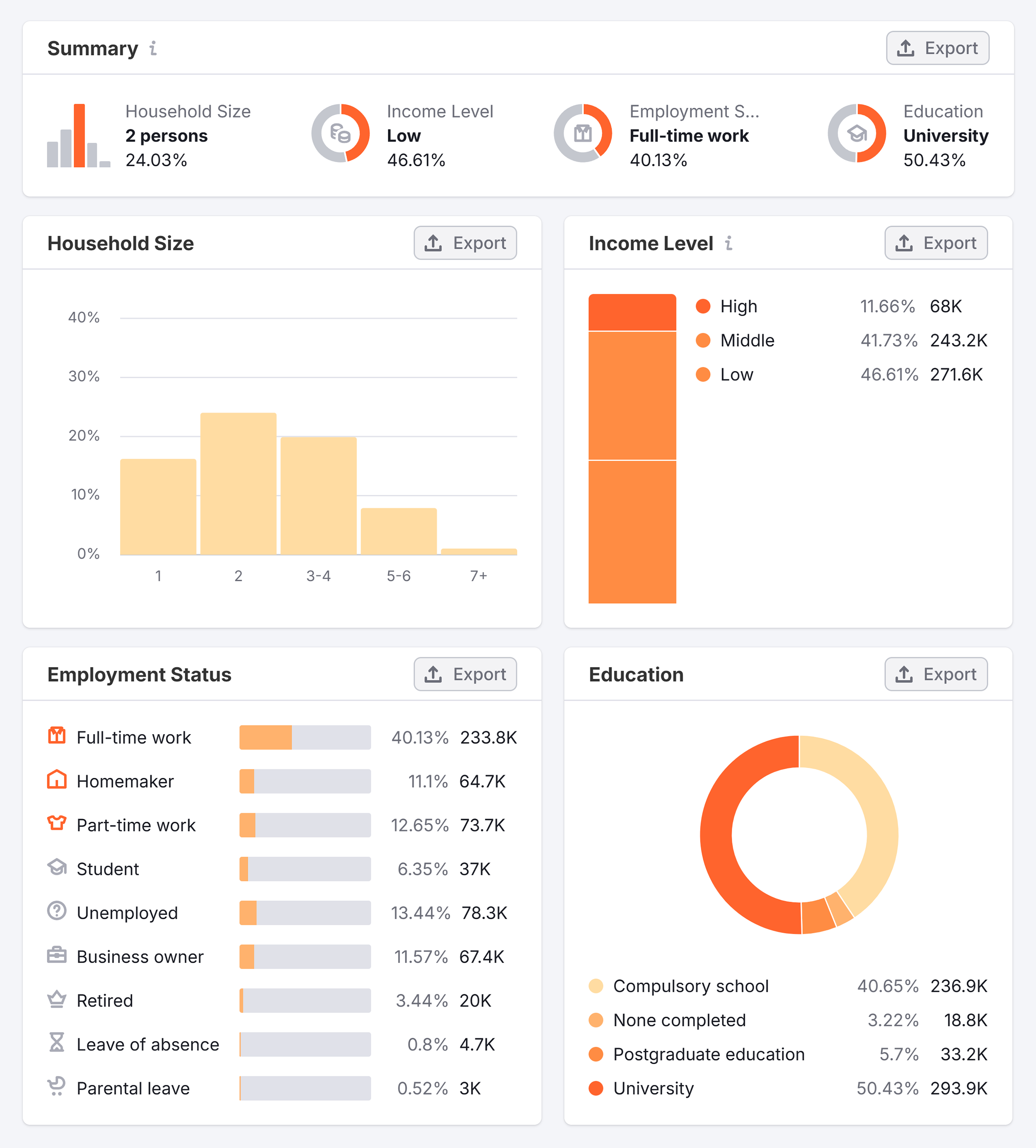
But my favorite report in this toolkit is the Behavior tab. It shows you the social media platforms your audience visits most often.

This data is invaluable for marketing campaigns. For example, I can see above that Backlinko’s target audience visits YouTube most often. And we’re taking action on that by creating YouTube videos.
Market Analysis
Finally, the Market Overview report shows you the landscape of a given niche.
For example, when I run the report for Backlinko, it shows me details like the level of consolidation in the market, the total available traffic, and a graph of the sites that are growing and dominating in our niche.
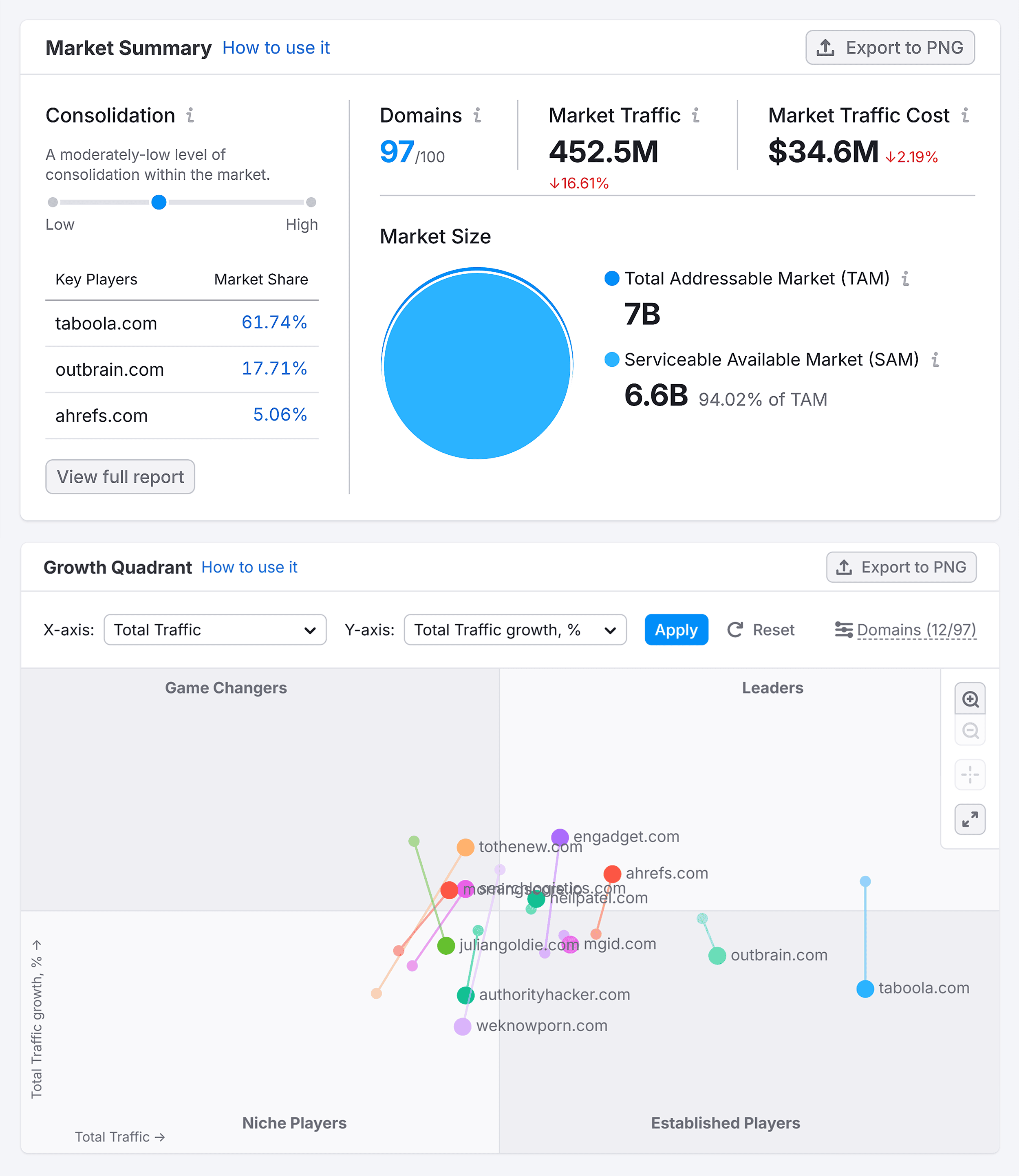
You can even see which sites get the lion’s share of traffic in that space. You’ll also see the traffic distribution and growth (or decline) for each one.
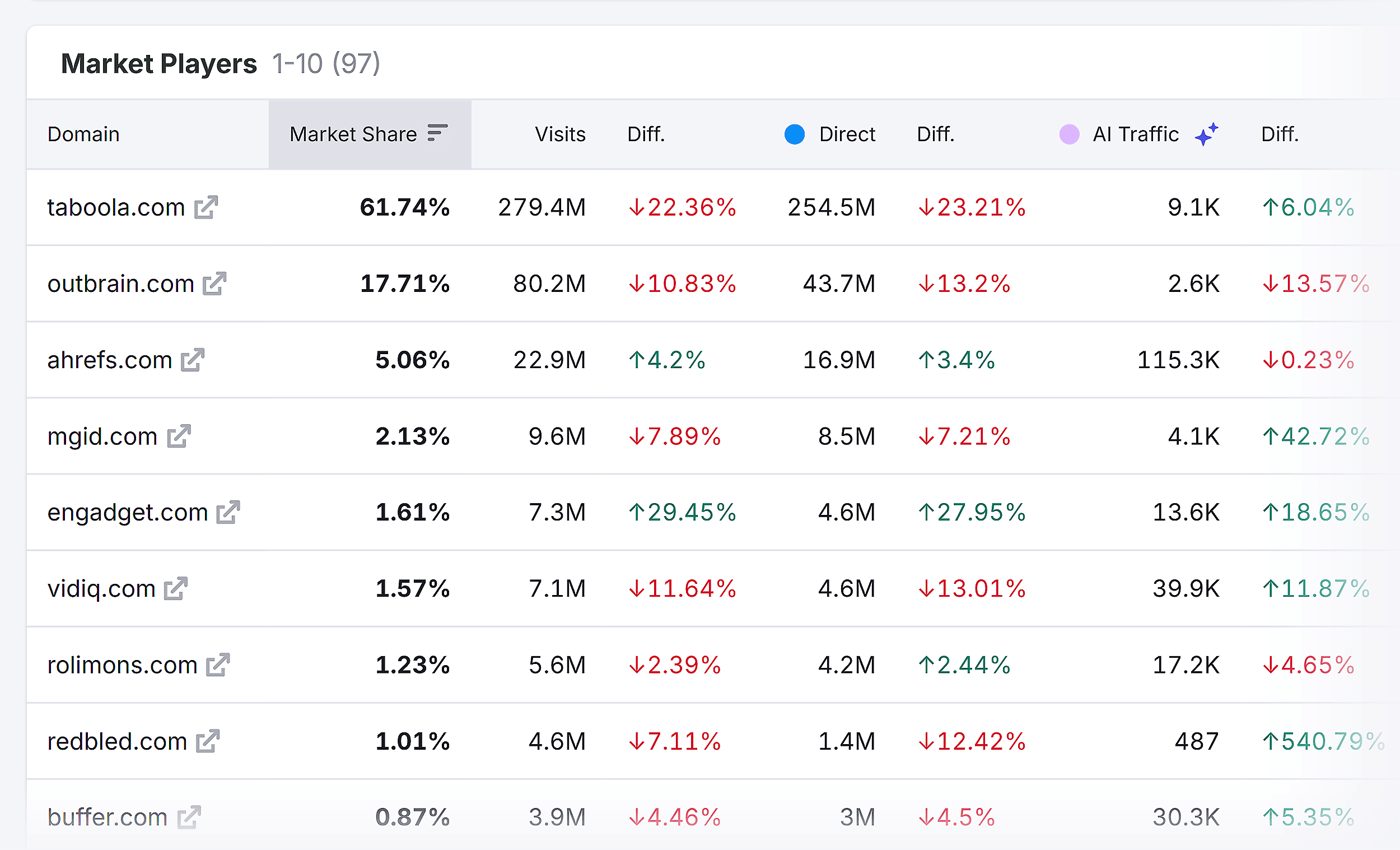
Why is this useful?
Well, let’s say you just took on a new client, and they’re in a niche you know nothing about.
It can take days of research to figure out who you’re even competing against. And who the established sites are.
Semrush’s Market Overview report makes this sort of market analysis much easier.
Content Toolkit
Semrush offers a few helpful tools for planning and creating content that’s optimized for SEO and AI tools.
These are especially handy for site owners that don’t have much content yet. But I also find them useful for coming up with new content ideas I might have missed.
Finding Topics & Generating Briefs
The Topic Finder works by taking a seed keyword and generating content ideas you can use.
But these aren’t just random AI-generated content ideas — they’re based on solid Semrush data.
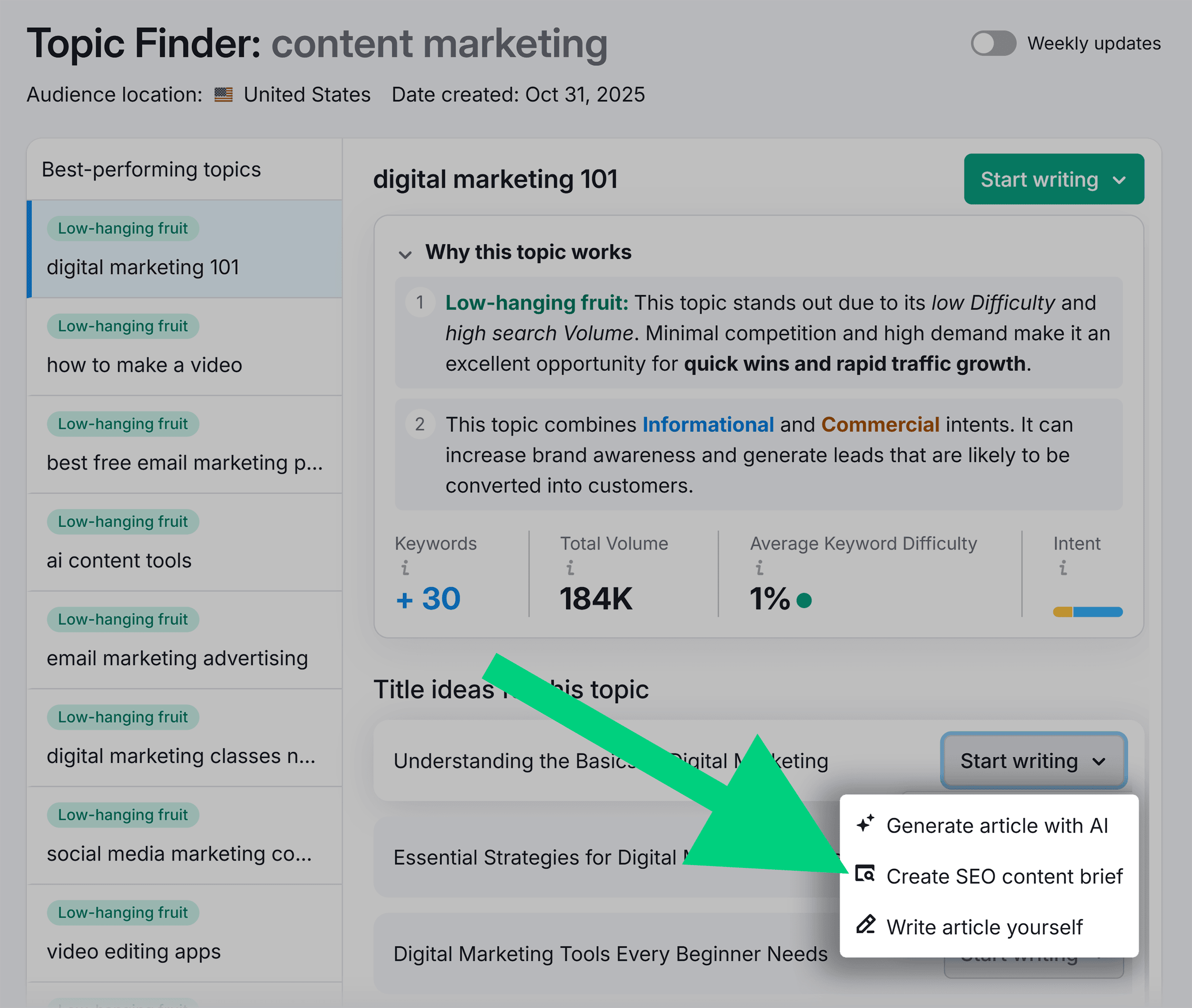
So you can prioritize the content topics you want to focus on by metrics like search volume and keyword difficulty.
Plus, you can click the “Start writing” button to take an idea straight to the content brief stage. Content briefs are a vital stage of the overall article creation process at Backlinko, and the brief creation tool lets you create these at scale.
The tool walks you through each stage, letting you choose which competing articles to analyze, which keywords to target, the overall structure of the post, and more.
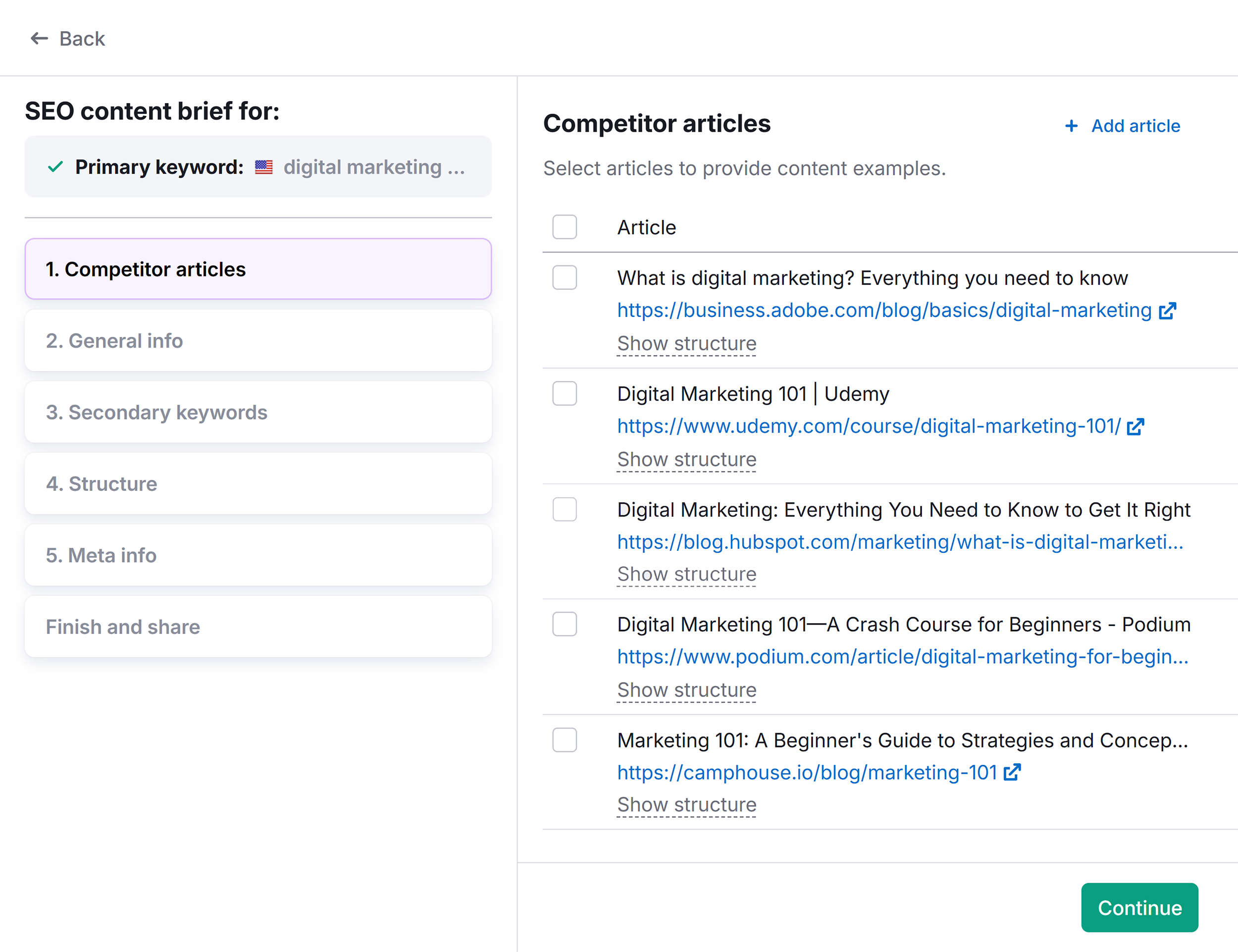
When you create the finished brief, it’s ready to go to your writing team. Complete with all the info from the brief stage…
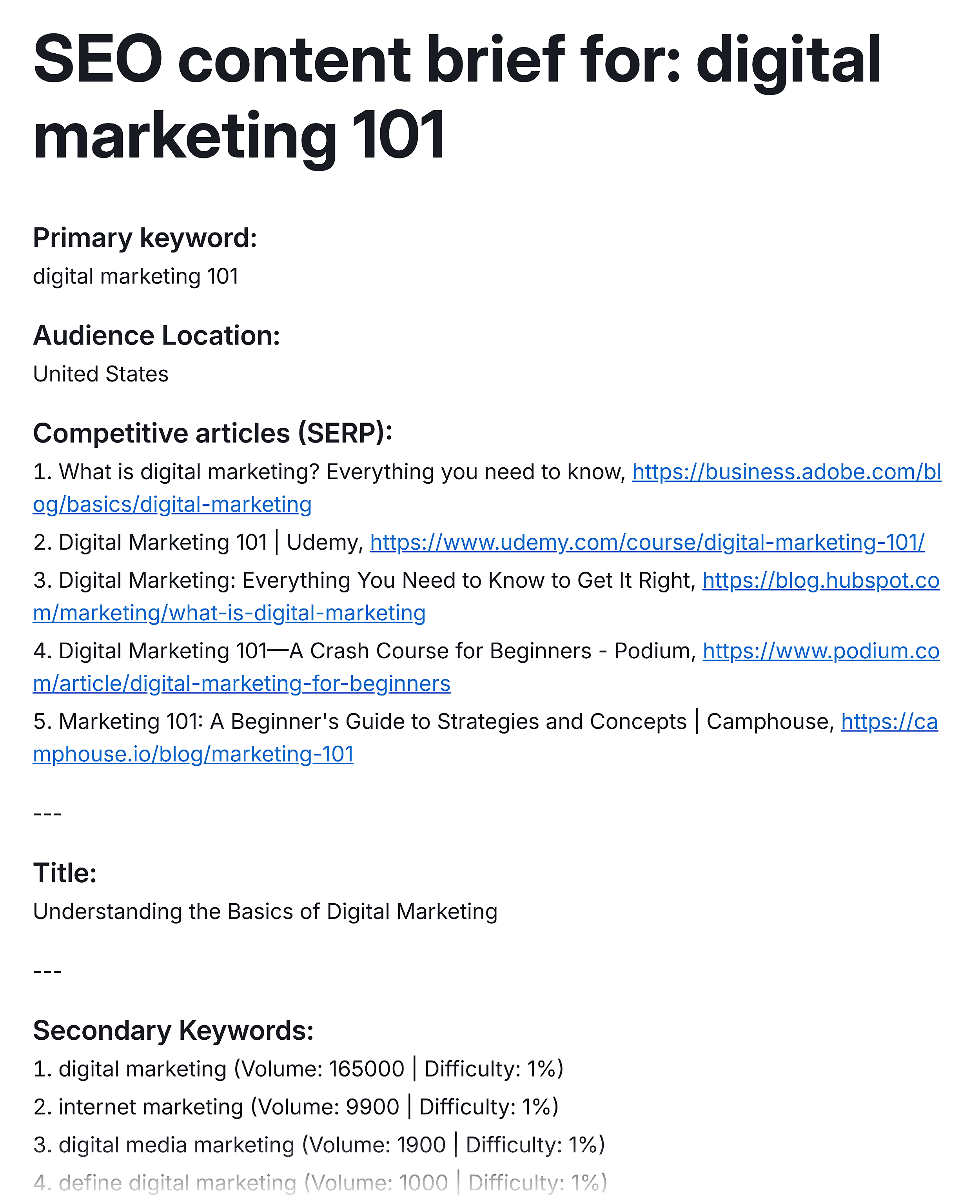
…and a fleshed out structure to follow:
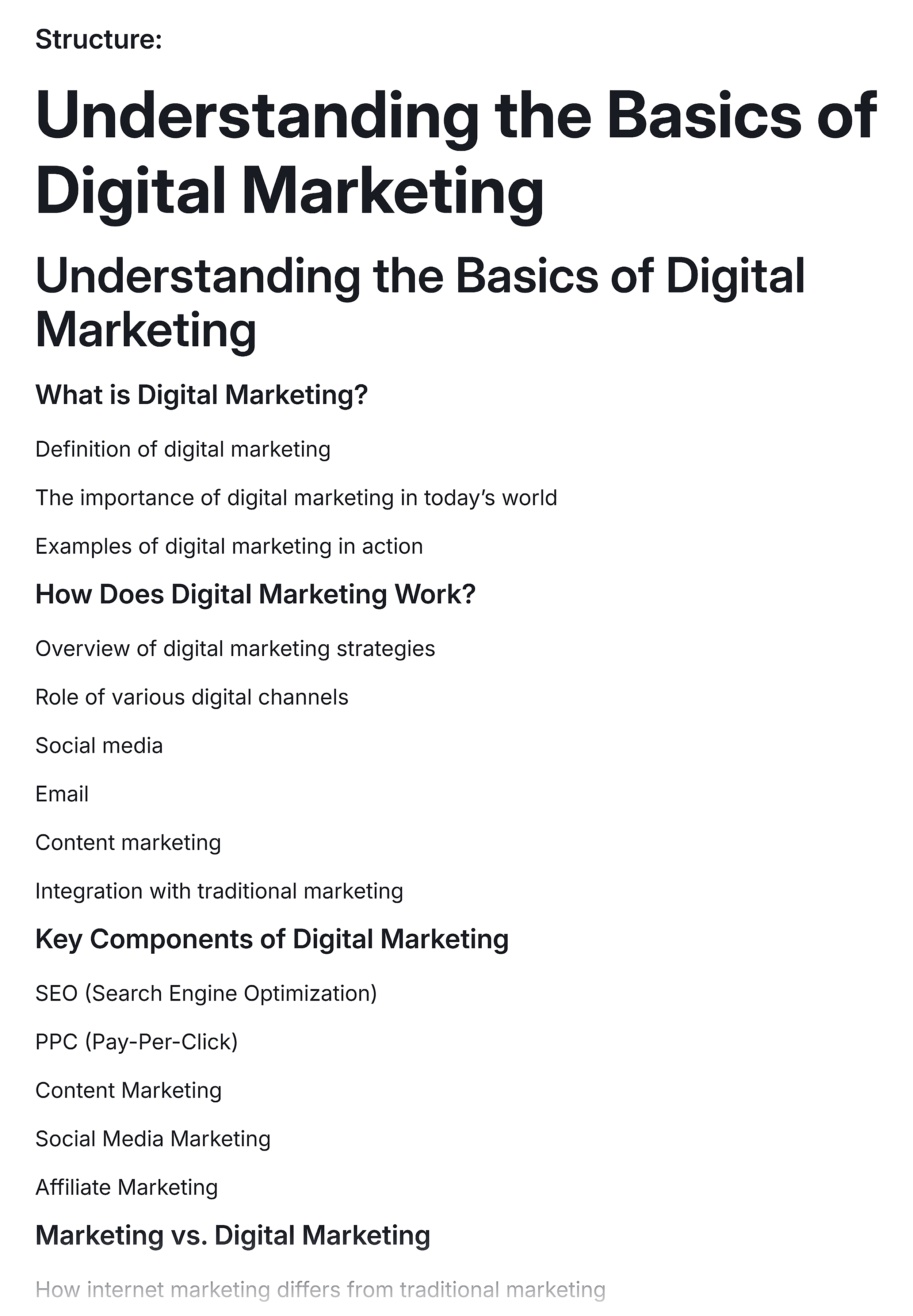
But if you click the “Generate SEO article” button, you’ll send the draft to the AI-powered content creation stage.
Creating and Optimizing Content
The AI Article Generator will take your brief and use it to create SEO-ready content.
I like this approach to AI-assisted content because you can actually edit the draft right there in the tool (as with any AI-generated content, you will need to edit it).
It’s not just spitting out a chatbot’s draft that you need to copy and paste into a doc.
You can even send the finished draft directly to Google Docs when you’re ready.

The tool will also give you AI SEO improvement suggestions and regular SEO recommendations too. This makes it a breeze to take your content from the ideation stage right through to publishing.
Advertising Toolkit
Semrush doesn’t just offer SEO tools. The platform is also stacked with tools for other areas of your marketing, and the first of these I’ll cover is the Advertising Toolkit.
View Competitor Ad Performance
You can use Semrush to see pretty much every ad that one of your competitors is running. And you can see how much traffic those ads bring in.

They even have estimated CPCs to give you an idea of how much that site is spending on Google Ads every month.
That’s already super valuable intel.
But the real gem here is the ability to see the exact ads that your top competitors are currently running.
View Competitor Ad Copy & History
The Ads Copies and Ads History tabs show you what the ads your rivals are running look like and how they’ve performed over time.

If you’re familiar with Quality Score, you know that one important factor is your ad’s click-through rate (CTR). The higher your CTR, the less you’ll often have to bid.
And if you see that a competitor has been using an ad for months or years, you KNOW that it’s getting a decent CTR. Otherwise, they wouldn’t be using that ad.
For example, the Ads History tab shows us that Amazon has consistently ranked their ad in the top position for the term “owala water bottle.”
That keyword likely drives many sales, so the ad has been running for more than a year.

And if you want to see even more ad copy and keywords to use as part of your PPC campaigns, head to the Competitors tab. And you’ll get a list of sites that are all bidding on the same keywords.

Display Ads Research
Semrush isn’t just for PPC ads.
They also have a solid display advertising feature in their App Center called AdClarity. This is a separate app, but if you opt for a Pro Advertising Toolkit subscription, you’ll also get access to AdClarity.

Not only can you see their display ads:

But you can even get a list of the exact sites that they’re advertising on:

But combine that with the Ad Clarity app and you get access to some immensely powerful advertising data.
Other features of the Advertising Toolkit include:
- Ads Launch Assistant to help you set up your first campaigns
- PLA Research to understand your rivals’ product listing ad (PLA) performance
- PPC Keyword Tool to help structure your keyword groups for Google Ads
Other Toolkits and Features
Semrush has a few other toolkits and features worth highlighting for specific use cases.
Local Toolkit
If you run a physical business, Semrush’s Local Toolkit can help you optimize your online presence and drive more customers to your store.
Its main tools include:
- GBP Optimization to update your Google Business Profile and track metrics like views, user actions, and your average rating
- Listing Management to automatically find opportunities to add your business to new directories — or correct the existing listings you have incorrect information on
- Review Management to monitor your Google reviews and compare your performance to your rivals
- Map Rank Tracker to get street-level rank tracking for your business

These tools provide incredibly valuable data for business owners. Being able to see how you stack up against your rivals at this level of detail makes it clear where you’re winning and where you’re not.
Social Toolkit
The Social Toolkit comes with five main tools to help with your social media marketing efforts:
- Social Poster for scheduling posts ahead of time
- Social Tracker for tracking any brand’s social performance
- Social Content Insights for post-level insights
- Social Analytics to assess your overall performance
- Social Content AI for AI-powered post, caption, and visual ideas
My personal favorite?
The Social Poster. There are a TON of social media scheduling apps out there. But since I already use Semrush, the Social Toolkit lets me manage my social media marketing all in the same platform.
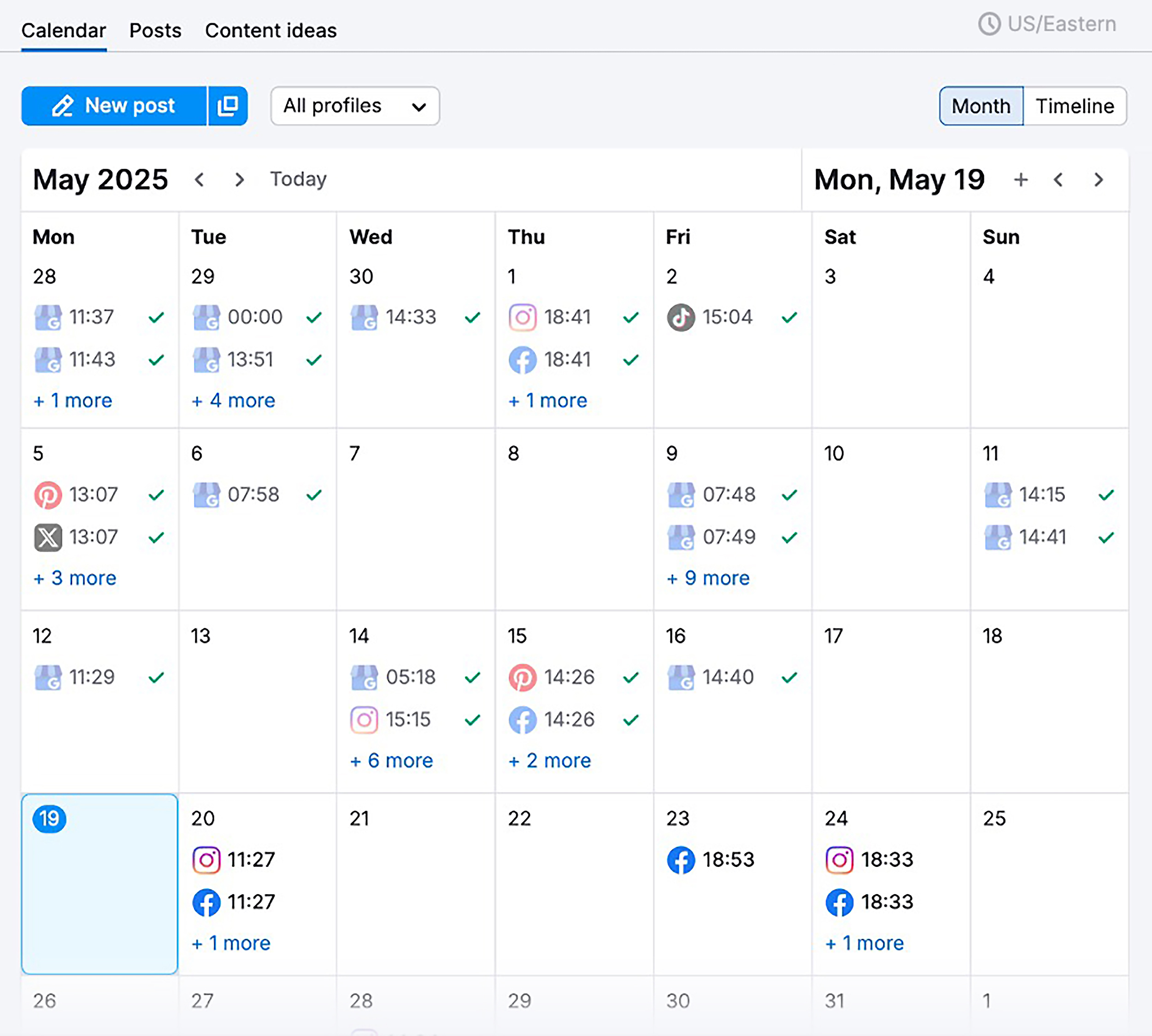
Plus, you can upload a CSV file to do this in bulk for up to 100 posts. This is a huge time saver.
App Center
The App Center is packed with tools for specific use cases (many with free trials). From AI optimization to paid advertising.

A few notable apps include:
- AdClarity for display ad intelligence (as I mentioned earlier, you can get this with a Pro subscription for the Advertising Toolkit)
- Exploding Topics for finding trending products and ideas
- Influencer Analytics to find influencers to partner with and manage your campaigns
My Reports
My Reports is Semrush’s built-in reporting tool. It’s especially handy for anyone using Semrush to report data to clients or key stakeholders in the business.
You can use various templates to get started, or create your own from scratch.
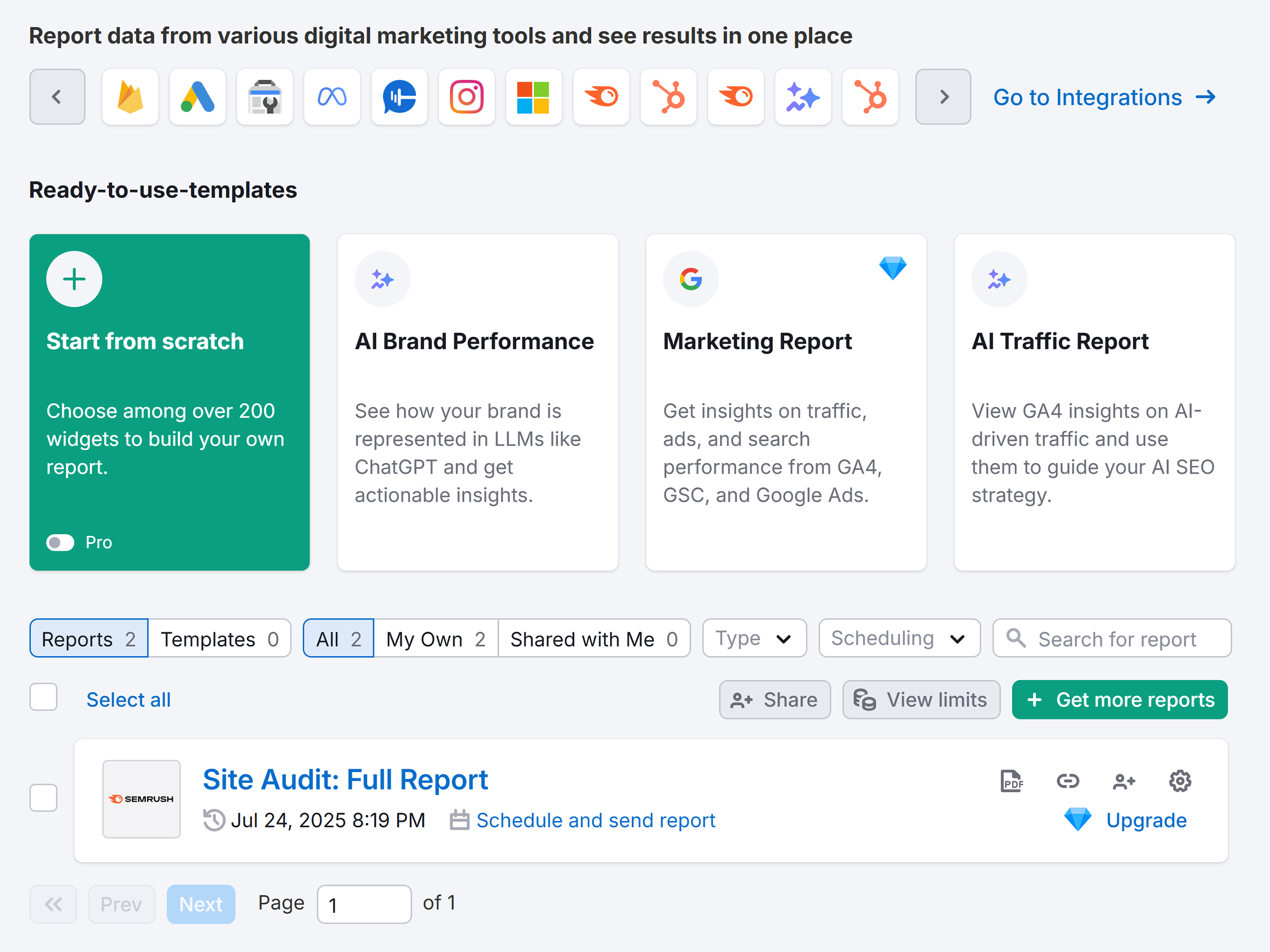
Then, you can pull in data from Semrush’s huge range of tools. Or you can connect to countless other data sources, like Google Search Console, Google Ads, and even other SEO platforms.

This lets you consolidate all your data sources in a way that’s easy to present to clients and team members.
The tool will put it all together for you in a nice PDF, and you can drag and drop widgets to only show the data that’s most important to you.
Semrush Support
I outlined my experience with Semrush’s customer support in my Ahrefs vs. Semrush comparison.
Semrush offers live chat while logged in:
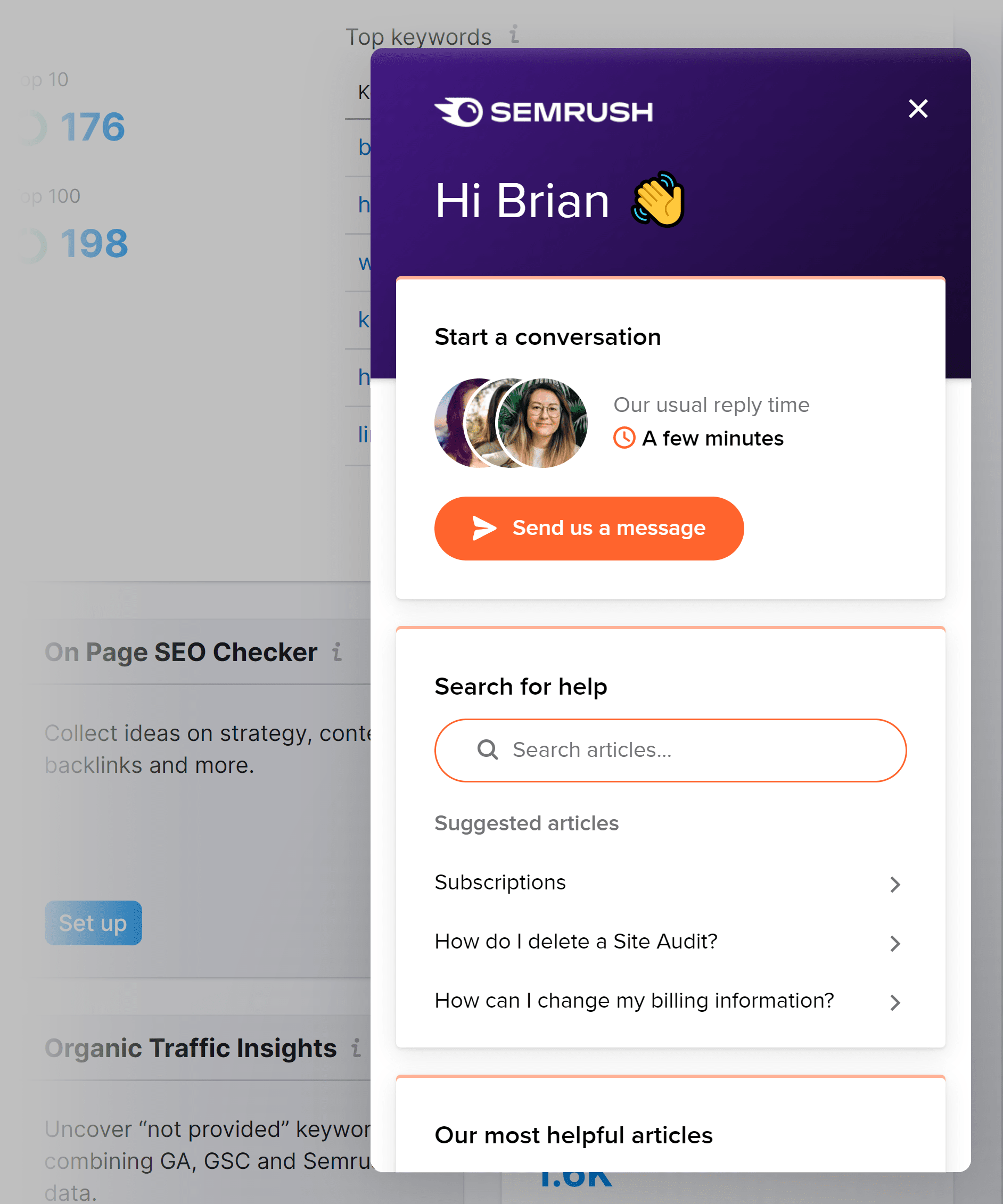
Overall, their support is excellent. And fast.
And they have a help center too, with guides for specific tools, and other aspects of the Semrush SEO suite.

Semrush Pricing
Semrush’s pricing varies depending on which toolkit(s) you subscribe to.
But now Semrush is offering Semrush One, a $199/month plan that includes both the SEO Toolkit and the AI SEO Toolkit, which is probably your best bet if you’re interested in driving brand visibility across the web.
Here’s a quick breakdown of individual toolkit pricing:
- SEO Toolkit: Pro plan ($139.95/mo), Guru plan ($249.95/mo), and Business plan ($499.95/mo). Higher tiers give you access to more projects, historical data, and extended limits.
- AI SEO Toolkit: $99/mo per domain
- Traffic & Market Toolkit: $289/mo
- Local Toolkit: Base ($30/mo) and Pro ($60/mo). Base gives you GBP Optimization and Map Rank Tracker. Pro gives you Listing and Review Management, along with API access and higher limits.
- Content Toolkit: $60/mo
- Social Toolkit: $250/mo
- Advertising Toolkit: Base ($99/mo) and Pro ($220/mo). Pro gives you AdClarity and more competitor data.
There is also an enterprise SEO solution, but you’ll need to contact the Semrush team to find out more about pricing for that.
If you’re not convinced about a paid plan, there is a free Semrush plan too. This gives you limited access to lots of their tools to try before you buy. Or you can use this link to get a 14-day trial of a Semrush One subscription.
Semrush: Things I Like
Let me now cover some of my favorite parts of the Semrush platform.
Reliable data: Data is the backbone of an SEO tool like Semrush. And Semrush’s SEO and PPC data are world-class and always up to date.
Unified platform: One of the strengths of Semrush is that everything is connected. Which can make some of their features faster and easier to use.
For example, when you analyze a site’s organic rankings, you can quickly see that site’s backlinks, traffic stats, and more. And clicking specific metrics (like backlinks) can take you to in-depth reports in other tools (like Backlink Analytics).
Unique set of SEO and PPC features: This SEO toolkit has so many features that I didn’t have a chance to cover all of them in this review. But you can learn more about them in my full Semrush guide.
So yeah, there are a TON of features inside Semrush. And the Semrush team is always innovating and adding new features to the platform.
Semrush: Things I Don’t Like
Here are some things about Semrush that I wasn’t a huge fan of.
Organic traffic estimates can be off: Like any SEO tool, Semrush’s organic traffic estimates aren’t always super accurate. This isn’t really a knock on Semrush specifically, as all SEO tools suffer from this.
Missing click data: If you want to really dig into a single keyword, Semrush does the job. But Ahrefs is a bit better in this regard.
Why? Ahrefs gives you more data to work with. Data that helps you decide whether or not a keyword makes sense for you.
For example, in Ahrefs you don’t just get monthly search volume. They also show you how many people click.

This is helpful data that Semrush doesn’t currently have.
Click-heavy UI: As you can probably tell from reading through this review, the platform has A LOT of features. This means that it usually takes 3-5 clicks to get to the specific report that you need. This is testament to the sheer power of the tool, but it can be a little overwhelming for beginners.
The Bottom Line: My Semrush Review
Semrush has a set of industry-leading features that are backed by a large index of keywords, backlinks, and advertising data. This is why Semrush has become one of the most popular and trusted marketing tools.
Personally, I’ve been paying for Semrush every month for about 13 years now.

I do SEO all day long. So I find myself logging into Semrush all the time to check my own site’s SEO health and rankings. I also use it a lot for competitor research.
Even though I only use maybe 10-15% of what Semrush offers, I still get enough value out of it to justify my monthly payment.
If SEO, PPC, and digital marketing in general are a big part of your business’s strategy, I recommend Semrush.
Backlinko is owned by Semrush. We’re still obsessed with bringing you world-class SEO insights, backed by hands-on experience. Unless otherwise noted, this content was written by either an employee or paid contractor of Semrush Inc.

